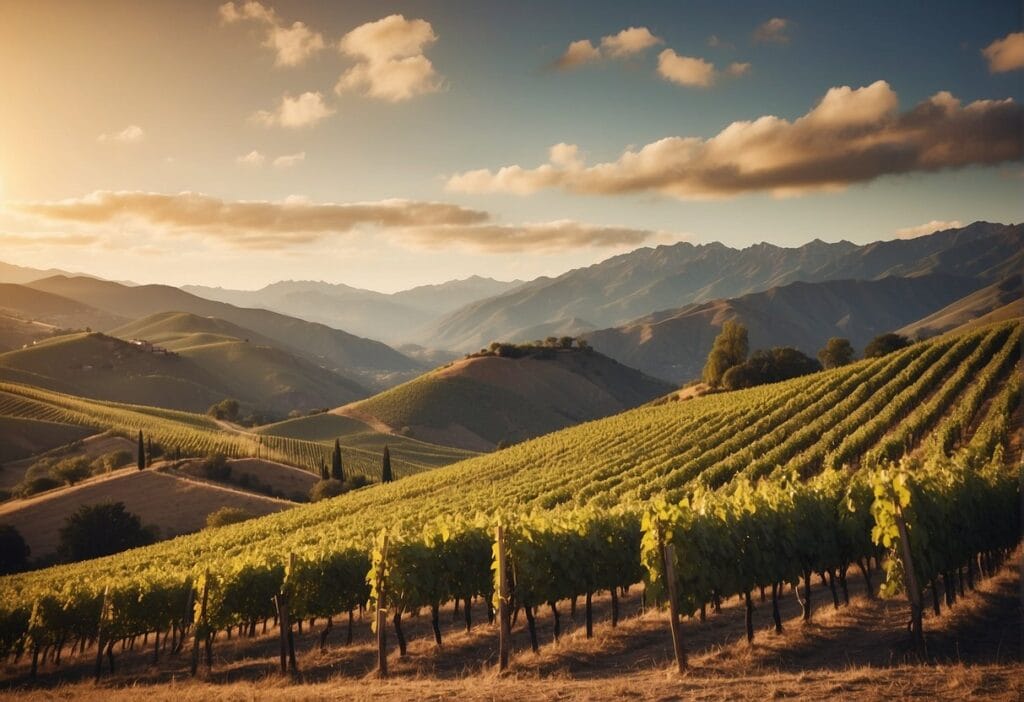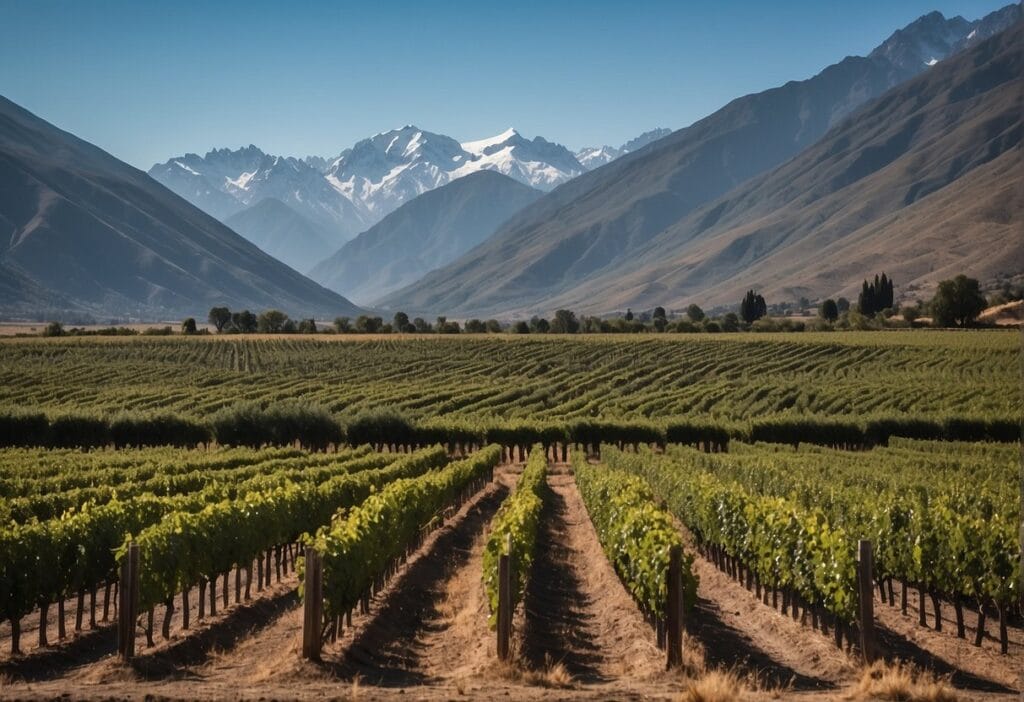Italy, renowned for its stunning landscapes and rich cultural heritage, boasts one of the most diverse and storied wine cultures in the world. As you explore Italian wines, you’ll discover that each wine region offers a unique palette of flavors and traditions, deeply rooted in the history and terroir of the area.
From the robust reds of Tuscany to the sparkling proseccos of Veneto, Italian wine regions reflect the country’s wide variety of climates and soils, each creating distinct wines that are celebrated globally for their quality and variety.
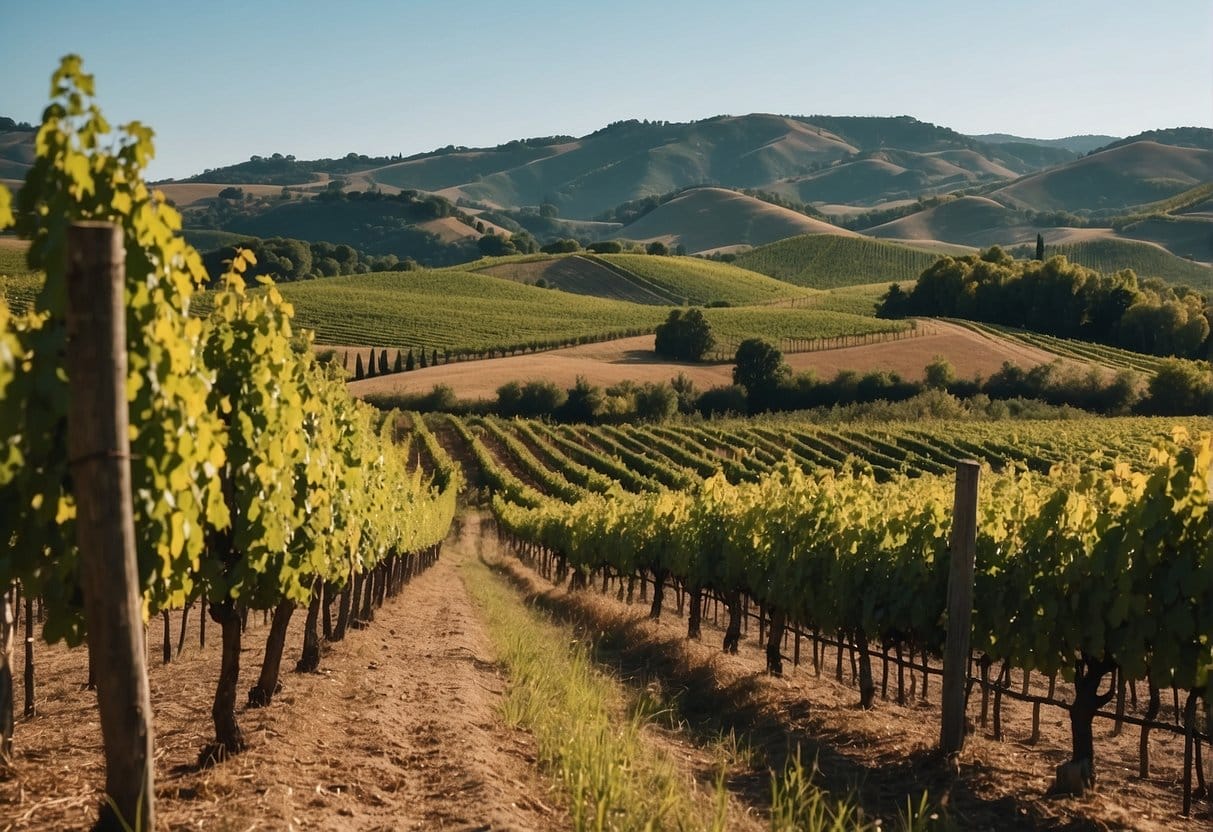
The northern regions of Italy, like Piedmont and Lombardy, are famed for their sophisticated red wines and elegant whites. Piedmont’s Barolo and Barbaresco are expressions of the Nebbiolo grape that are as prestigious as they are palatable, while Lombardy’s Franciacorta gives champagne a run for its money with its exquisite fizz. Further south, the heart of Italian winemaking beats in Tuscany, home to the beloved Chianti and the prized Brunello di Montalcino.
Here, the Sangiovese grape achieves its fullest expression under the Tuscan sun; its wines are your faithful companions at the dining table, pairing exceptionally well with a wide range of Italian dishes. Meanwhile, the sun-drenched vineyards of Sicily and Sardinia produce robust, fruit-forward wines that encapsulate the warmth of the Mediterranean.
Key Takeaways
- Italy’s wine regions offer a diverse range of flavors unique to their climate and terroir.
- Northern Italy is celebrated for sophisticated reds and elegant sparkling wines.
- Central Italy, particularly Tuscany, is synonymous with Sangiovese-based wines famed for their versatility in pairing.
History and Significance of Italian Wine
Italian wine boasts a heritage rooted in ancient times and has played a pivotal role in wine culture both regionally and globally. Your appreciation for its storied past and its standing in today’s wine market will deepen as you explore the aspects that make Italian winemaking truly unique.
Origins and Wine Production Evolution
The journey of Italian wine begins over 4,000 years ago, with the ancient Greeks and Etruscans fostering the initial cultivation of vines. Through the Roman Empire, Italy’s wine production techniques were refined and spread across Europe. As you sip on an Italian vintage, you’re tasting the result of millennia of dedicated winemaking evolution.
Classification Systems: DOC, DOCG, and IGT
To navigate Italian wine, understanding the country’s classification system is key. The Denominazione di Origine Controllata (DOC) and the more stringent Denominazione di Origine Controllata e Garantita (DOCG) labels assure you of the geographic authenticity and quality. The Indicazione Geografica Tipica (IGT) classification allows winemakers to experiment while still showcasing regional character.
Italian Wine Regions Overview
Italy’s diverse climate and terrain are mirrored in its wine regions, with each area imparting distinct characteristics to its wines. From the robust Barolos of Piemonte to the light, effervescent Proseccos of Veneto, the variety is astounding. A map of Italy’s wine regions reveals a tapestry of more than 20 unique areas, each contributing to the country’s illustrious wine reputation.
Influence of Italian Wines Globally
Italian wines have charmed the world, with their inherent quality and diversity gaining international acclaim. The influence of wines like Chianti and Barolo on global wine culture is profound, often setting the benchmark for certain grape varieties and wine styles.
Italy’s Place in the World Wine Market
In the arena of international wine production, Italy competes closely with France for the top spot. The value of Italian wines, especially when it comes to exports, is a testament to their global importance, with Italy often leading the world in volume of wine produced.
Key Grape Varieties in Italy
Your exploration of Italian wines isn’t complete without the indigenous grape varieties that are the soul of Italian viticulture. Sangiovese and Nebbiolo are among the stars, offering a range of flavors from robust and tannic to floral and delicate. With over 350 varieties officially recognized, Italy’s grapes are a treasure trove awaiting your discovery.
Northern Italian Wine Regions
When you explore Northern Italy, you’re greeted with a variety of prestigious wine regions, each boasting its own unique grapes and wine styles.
Piedmont, nestled at the foot of the Alps, is esteemed for its robust Barolo and Barbaresco wines, crafted from the Nebbiolo grape. Not only does it offer these reds, but Piedmont is also home to the vibrant Asti sparkling wines, notably the sweet and fizzy Moscato d’Asti.
Venture into Lombardy, and you have the opportunity to savor the Franciacorta—Italy’s answer to champagne, predominantly made from Pinot Nero (Pinot Noir) and Chardonnay grapes.
Here’s a brief overview highlighting the key grapes and wines from each region:
- Veneto: Famous for the light and crisp Prosecco, made from Glera grapes, and the well-structured Valpolicella blends, including the cherished Amarone della Valpolicella, utilizing primarily Corvina grapes, alongside Rondinella and Molinara.
- Trentino-Alto Adige: Here you’ll find excellent Pinot Grigio, full-bodied Sauvignon Blanc, aromatic Gewürztraminer, and refreshing Pinot Bianco.
- Liguria: Offers the delightfully crisp Vermentino, perfect for a light, seaside sip.
- Friuli: Is renowned for its white wines, with grapes like Friulano and Ribolla Gialla leading the charge for distinct regional flavors.
- Lombardy’s Valtellina: Introduces you to another expression of Nebbiolo, known locally as Chiavennasca.
Each glass from these regions reflects the rich history and terroir where they’re grown, offering you a flavorful journey through Northern Italy. Whether you’re a fan of robust reds or elegant whites, these regions have something to entice your palate.
Piedmont Wine Region
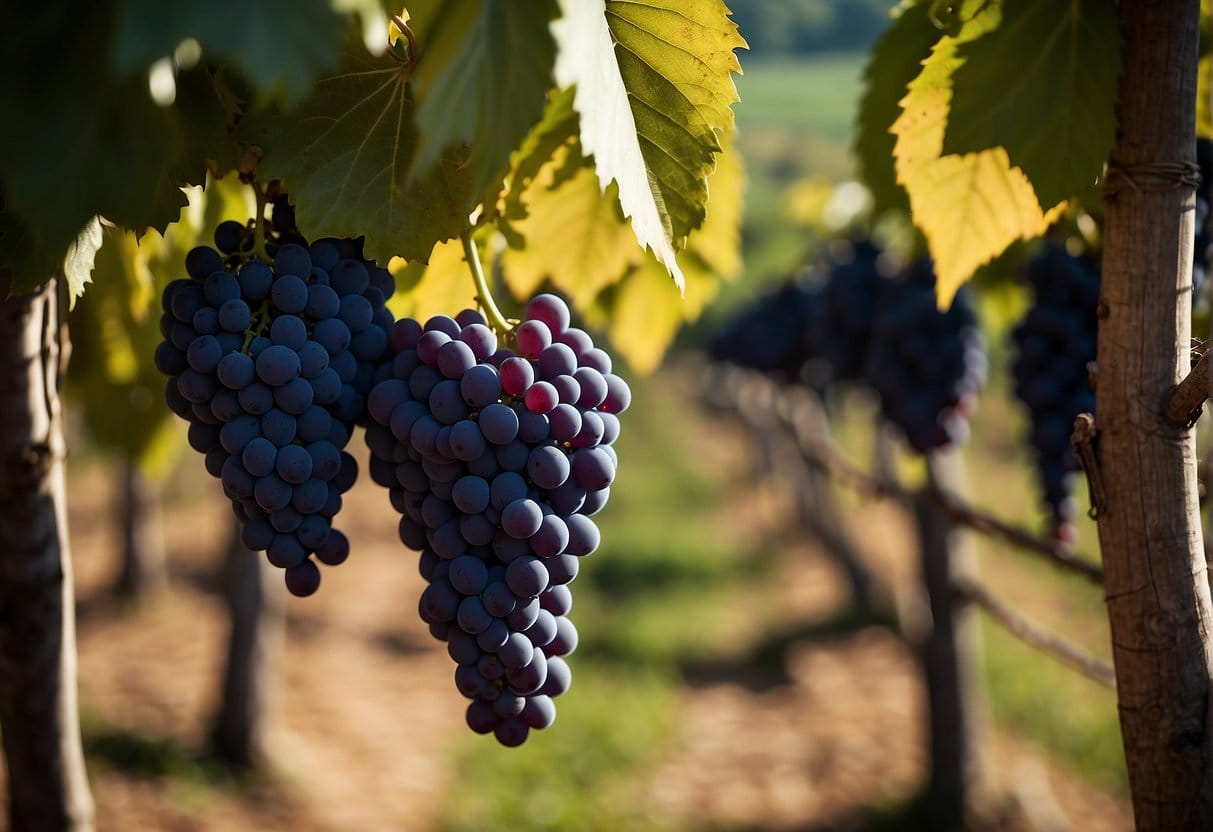
As you explore Italy’s esteemed Piedmont wine region, you’ll discover an area steeped in vinicultural heritage. Nestled at the foot of the Alps, Piedmont is synonymous with prestigious wines such as Barolo and Barbaresco, both renowned for their robust flavors and aging potential.
- Barolo: Often referred to as the “king of wines,” it is crafted exclusively from the Nebbiolo grape. These wines are cherished for their rich textures and deep complexities.
- Barbaresco: Another jewel of Piedmont, also made from Nebbiolo grapes, offering an elegant alternative to the typically fuller-bodied Barolo.
Nebbiolo is the star grape of the region, famed for its significant role in creating these revered reds. Its wines are noted for their ability to age gracefully, developing nuanced aromas over time.
For those with a sweeter palate, Piedmont doesn’t disappoint. The region also produces the ever-popular, lightly sparkling Moscato d’Asti. This sweet, perfumed wine is perfect as a dessert accompaniment or a celebratory toast.
- Moscato d’Asti: Aromatic and sweet with a gentle effervescence and typically lower in alcohol, it’s a delightful choice for any occasion.
Your exploration isn’t complete without experiencing wines made from the Barbera grape. With its approachable price point and versatile nature, Barbera-based wines exude bright acidity and lush fruit flavors, making them crowd-pleasers.
- Barbera: Known for high acidity and low tannins, it often presents flavors of cherries and spices.
Whether you’re savoring a glass of robust Barolo or enjoying the sweetness of Moscato, Piedmont offers a range of wines that promise to enchant your palate with every sip.
Veneto Wine Region
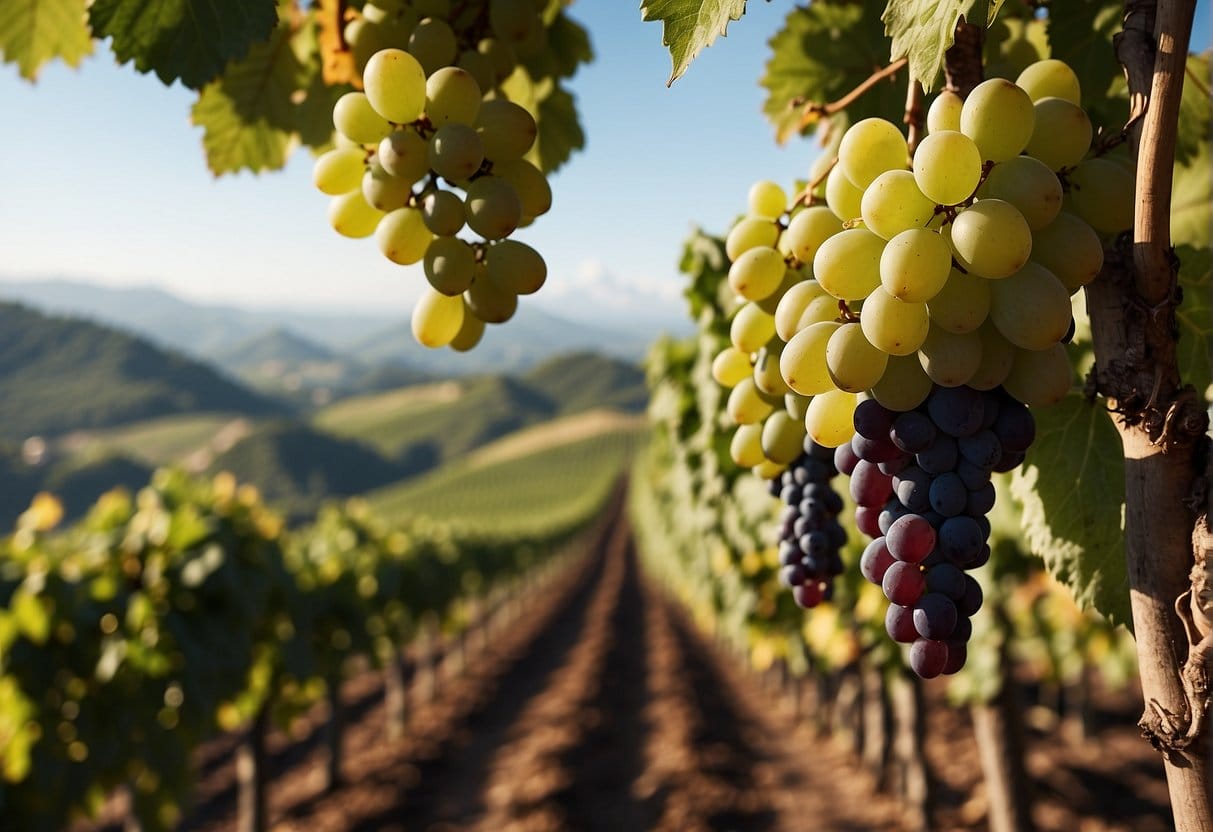
The Veneto wine region, nestled in Italy’s northeast, is renowned for its diverse selection of wines. You’ll discover that this area seamlessly blends tradition with innovation, creating unique tasting experiences.
Valpolicella stands as a jewel in the Veneto wine crown, famous for its robust red wines. Celebrated for its Amarone della Valpolicella, this wine is a must-try. It’s crafted using Corvina grapes, which are partially dried to concentrate their flavors, creating a rich and intense character.
Your exploration of Veneto wouldn’t be complete without savoring a glass of Prosecco. Known globally, Prosecco is a sparkling wine offering refreshing flavors that make it perfect for celebrations or a casual brunch.
Soave, another significant wine from the region, gives you taste of elegance with its white wines. These wines mainly use the Garganega grape, presenting you with flavors that are subtle yet complex.
| Key Wine Types | Grape Varieties |
|---|---|
| Valpolicella Reds | Corvina, Rondinella, Molinara |
| Sparkling Prosecco | Glera |
| White Soave | Garganega |
Make sure to indulge in the varied bouquet of Veneto’s wines, where each sip tells a story of the region’s rich viticultural heritage and the expertise of its winemakers. Whether you’re in for a light and crisp Prosecco or a complex Amarone, Veneto’s wines are sure to captivate your palate.
Lombardy Wine Region
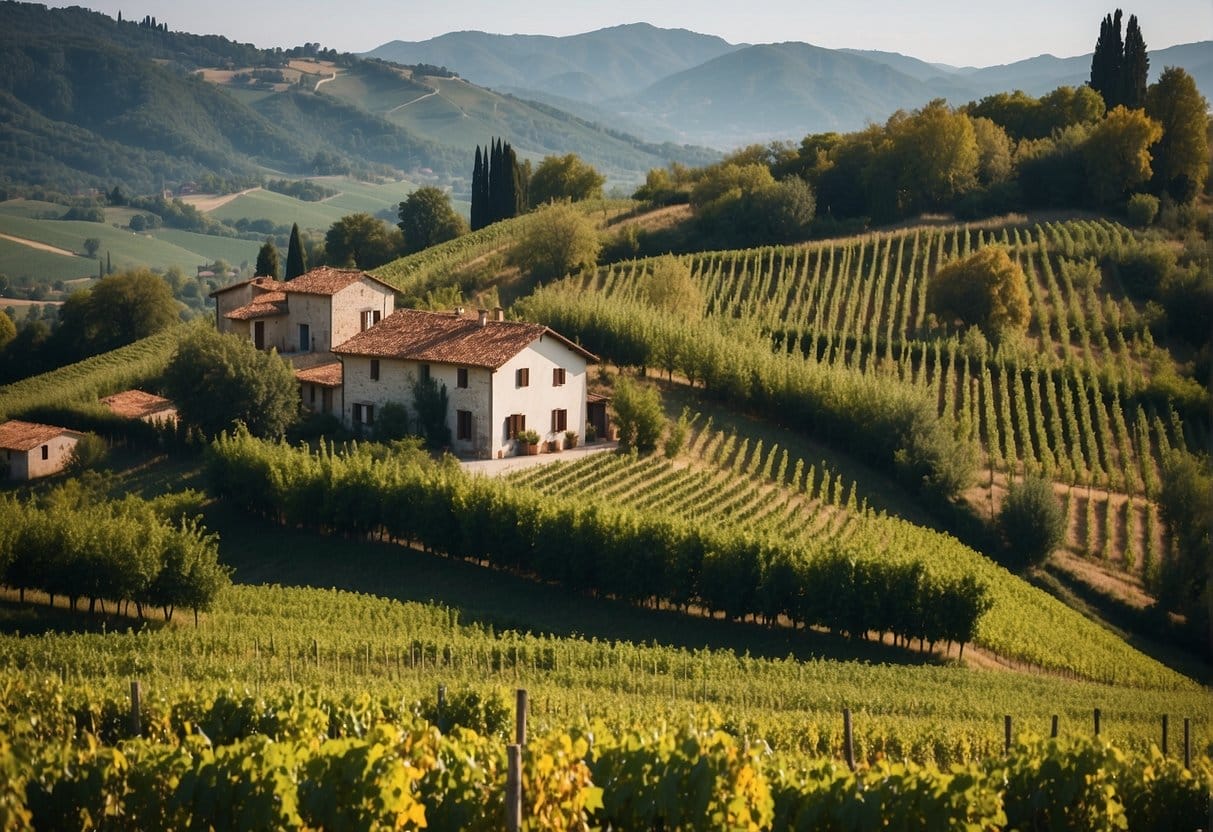
When you explore Italy’s revered wine regions, Lombardy might capture your interest with its distinctive viticultural offerings. This northern area, cradled by the Swiss Alps and the Po River basin, boasts a range of microclimates conducive to diverse wine production.
Franciacorta stands out in your Lombardy wine journey. Famous for its sparkling wines that rival Champagne, Franciacorta ensures a luxurious sipping experience, with vinification methods that emphasize quality. The wines here typically use Chardonnay, Pinot Nero (Pinot Noir), and Pinot Bianco grapes, with the latter being closely related to Pinot Grigio, a variety you’re likely familiar with.
While Pinot Grigio itself is not the star of Lombardy, its presence resonates in the terraces of Oltrepo Pavese—another prominent wine-producing area in the region—where sparkling and still wines alike benefit from the grape’s versatility.
Lombardy’s contribution to the Italian wine mosaic includes not only sparkling treasures, but also robust reds and delicate whites, served across the world. Valtellina, another jewel in the Lombard crown, offers wines made from the Chiavennasca grape, the local name for Nebbiolo, echoing the variety’s alpine terroir.
When you toast with a glass of Lombardy’s finest, remember you’re enjoying the confluence of alpine freshness and rich, historical tapestries of Italian winemaking.
| Notable Wines | Key Areas |
|---|---|
| Franciacorta | Franciacorta Region |
| Nebbiolo | Valtellina |
| Pinot Noir | Oltrepo Pavese |
Indulge in the elegance of Lombardy wines and savor the flavors shaped by this unique Italian region.
Trentino-Alto Adige Wine Region
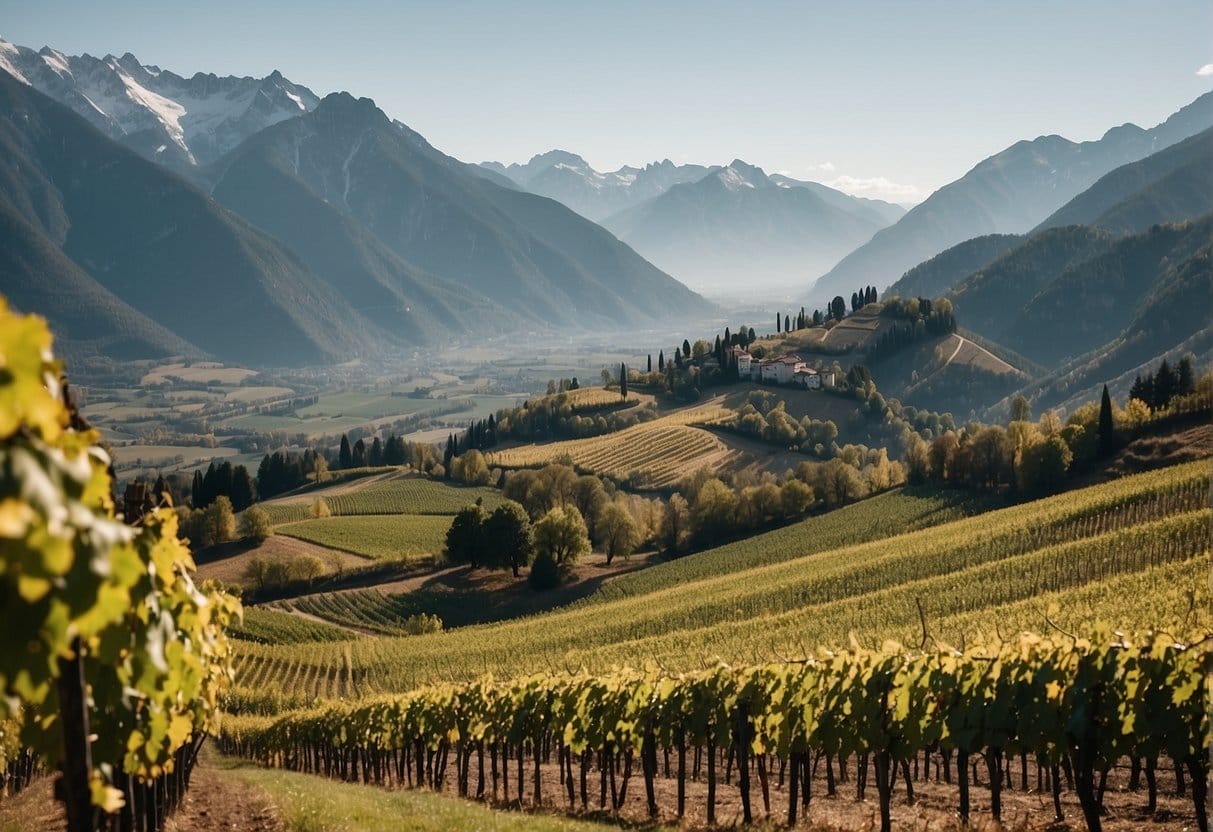
When you explore Trentino-Alto Adige, you’re discovering Italy’s northernmost wine region, renowned for its diverse variety of wines. Nestled between the snowy peaks of the Alps and the lush valleys, the region is split into two distinct areas: Trentino to the south and Alto Adige (also known as Südtirol) to the north.
Trentino is well-known for its rich, exuberant red wines. However, you’ll find that white wines also have their place of honor here. The distinct microclimates and fertile soil allow for versatile winemaking.
Moving upwards, Alto Adige will enchant you with its picturesque landscapes and Germanic influence. Here, the Pinot Bianco grape shines, producing crisp, refreshing wines with a delightful bouquet that reflects the unique terroir of the region.
| Key Varietal | Region |
|---|---|
| Pinot Bianco | Alto Adige |
| Teroldego | Trentino |
As you sip a glass of Pinot Bianco, notice its elegant balance with aromatic notes that can range from fresh green apple to ripe pear. It’s a testament to Alto Adige’s mastery in creating wines that truly resonate with the character of their environment.
Whether you’re traversing through the apple orchards of the Adige valley or enjoying the tranquility of Trentino’s lakes, remember that each glass tells a story of the land, the climate, and the tradition that it originates from.
Friuli Wine Region
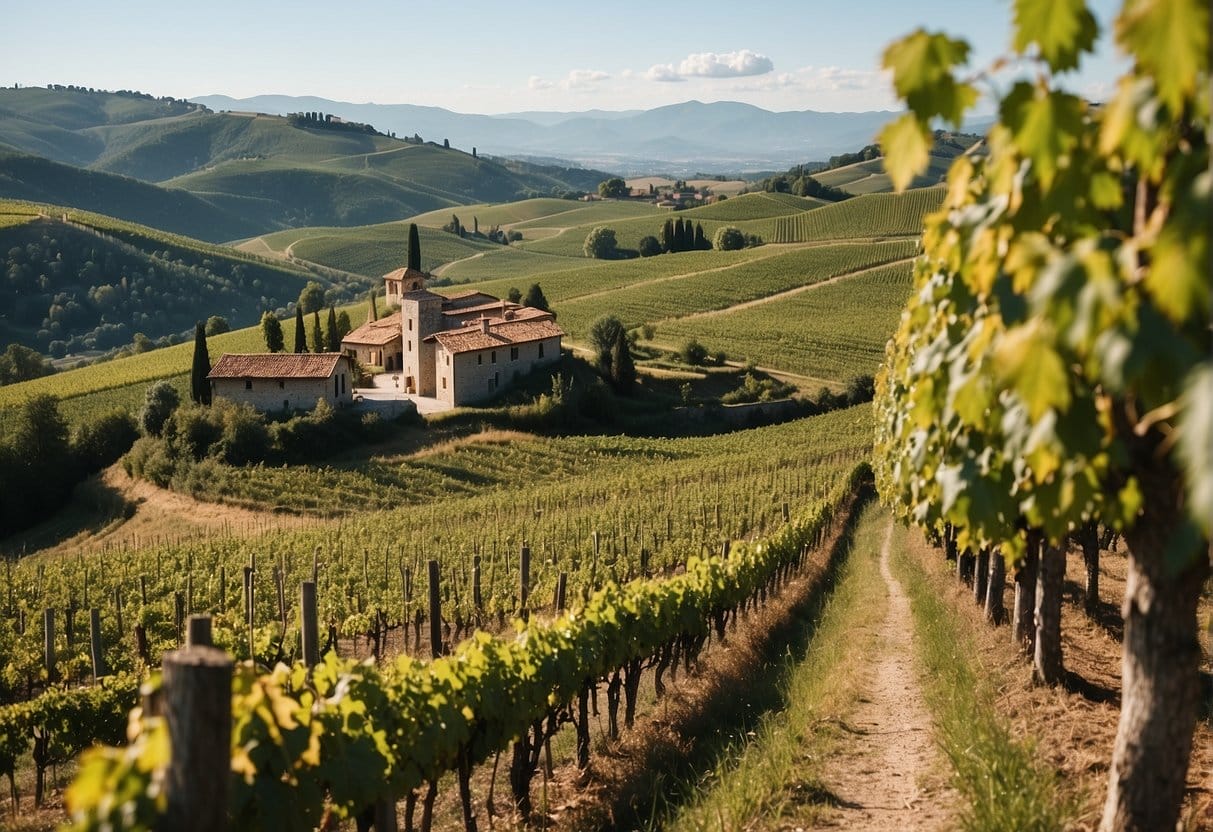
In the northeast corner of Italy, you’ll find the charming Friuli-Venezia Giulia wine region. It’s a place where the Alps meet the Adriatic Sea, framing a picturesque landscape known for its distinctive wines. In Friuli, vineyards sprawl across rolling hills, bordered by Austria and Slovenia.
Notable Wines and Grapes
Friuli is celebrated for its white wines that are as refreshing as they are flavorsome. Here’s a taste of what you can expect:
- Sauvignon Blanc: Friuli’s version of this popular varietal retains a crisp edge and is noted for its aromatic bouquet.
- Gewürztraminer: Your palate will be greeted by a spicy and aromatic profile that is a hallmark of wines from this region.
Key Characteristics
Friuli’s wine profile is diverse, and it’s particularly renowned for light-bodied whites with a clear, vivid hue and delicate mineral undertones. As you explore the wines of Friuli, you’ll notice the varietals carry signature flavors unique to the region’s terroir.
Soil Composition:
- Gravel
- Limestone-rich marl
The marriage of these soils with the local climate results in wines that are not just refreshing but carry a certain minerality that is difficult to find elsewhere.
When visiting Friuli or sampling its wines, you’ll delight in the authenticity of the region and its dedication to winemaking. Your taste buds may find a new favorite among the vibrant whites characteristic of this hidden gem in Italy’s viticultural crown.
Liguria Wine Region
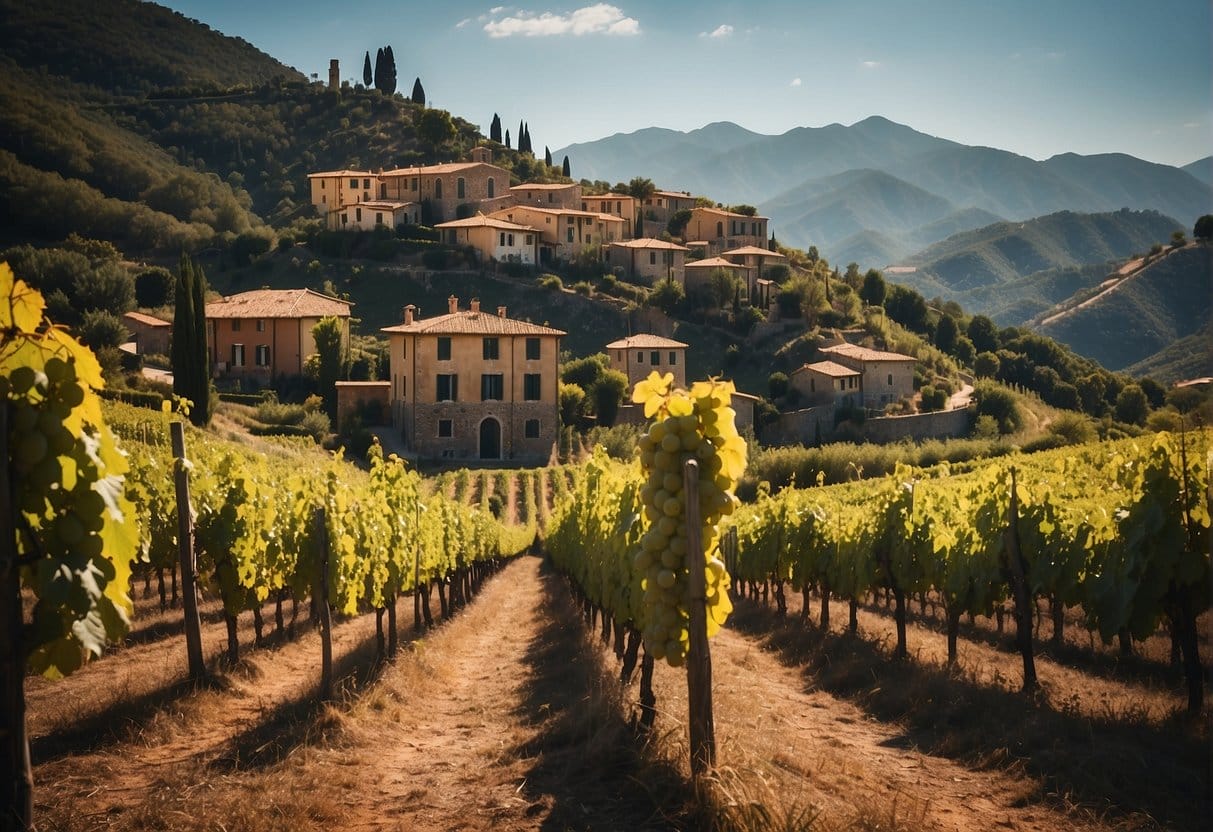
Nestled in the northwest of Italy, the Liguria wine region is known for its distinctive coastline and steep terrain. The region is often likened to a crescent moon, with a coastal stretch that offers a picturesque setting for vineyards that cling to the hillsides. Here, you will discover wines that reflect the maritime influence and rugged landscape of the area.
Liguria’s wine production is modest in volume but rich in variety, characterized by both reds and whites. Among the white wines, Vermentino is a standout variety, prized for its crispness and aromatic qualities. These wines typically exhibit floral and citrus notes, making them delightful companions to the local seafood cuisine.
| Main White Grapes | Primary Red Grapes |
|---|---|
| Vermentino | Rossese |
| Pigato | Ormeasco |
| Albarola | Ciliegiolo |
You can explore Liguria’s wines through several designations, each with its unique expression of the local terroir. The Cinque Terre DOC, for example, is renowned for producing white wines that capture the essence of the region. These wines are crafted from terraced vineyards that seem to rise from the Mediterranean Sea.
Liguria’s charm extends beyond just its wines; it’s a region where the love of food and drink is an integral part of the culture. Pair a chilled glass of Vermentino with a plate of freshly caught fish, and you’ll experience a true taste of Ligurian harmony. So, when you have the chance to sample Ligurian wine, take a moment to appreciate the centuries-old winemaking traditions and the unique character of this Italian gem.
Valtellina Wine Region
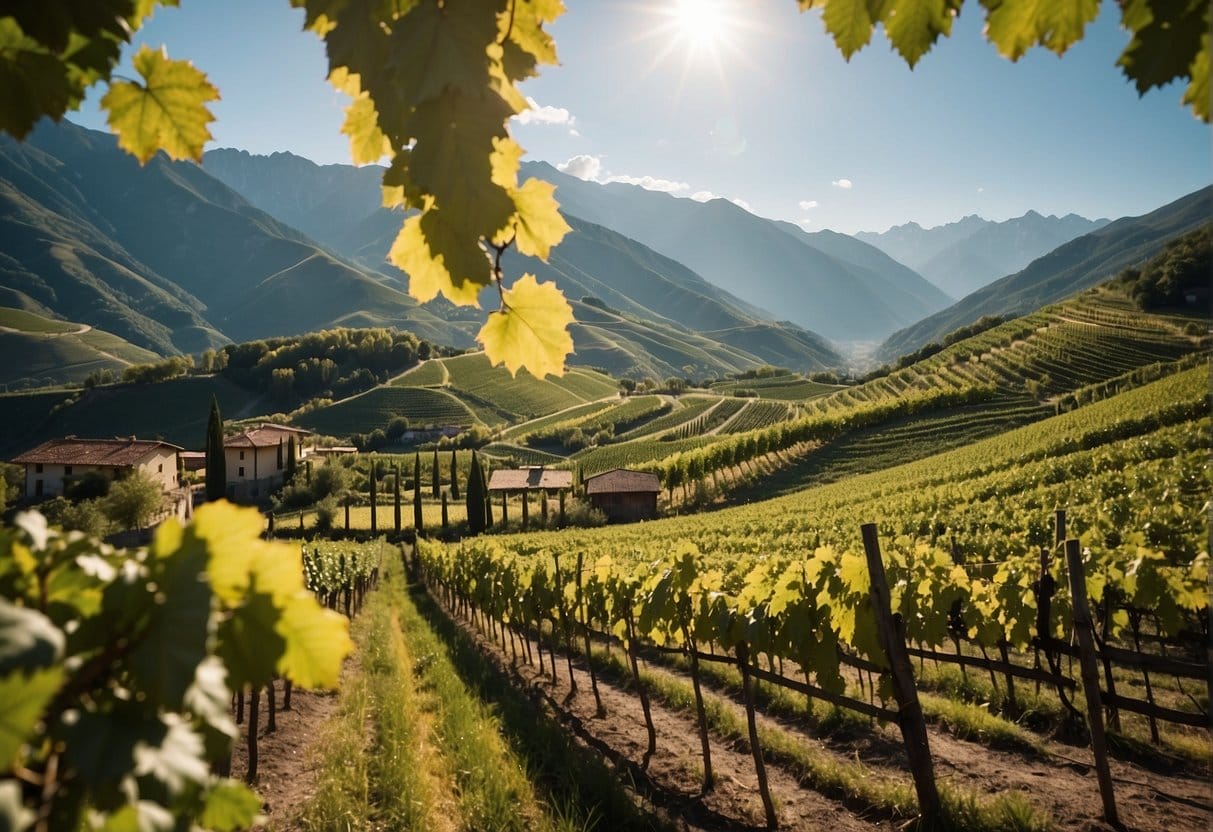
Nestled in the heart of Lombardy, Valtellina is your picturesque destination for discovering Italian Alpine wines. As you explore this charming region, you’ll find yourself surrounded by the majestic Rhaetian Alps, providing a perfect backdrop for the terraced vineyards.
In Valtellina, Nebbiolo—locally known as Chiavennasca—reigns supreme. This varietal thrives in the valley’s unique microclimate, characterized by its cool temperatures and plentiful sunlight. Your palate will be delighted by the distinctive Nebbiolo wines which are structured and complex, often with a tantalizing aromatic profile reminiscent of cherries, violets, and tar.
| Key Information | Valtellina Wine Region |
|---|---|
| Dominant Grape | Nebbiolo (Chiavennasca) |
| Climate | Alpine, cool temperatures, sunny |
| Soil Types | Sandy, silty, with granite rock bed |
| Notable Wines | Valtellina Superiore, Sforzato |
Your journey through Valtellina should include a tasting tour where you can savor the Superiore and Sforzato wines, which exhibit the grape’s capability to achieve elegance and depth. The patience required to produce these wines is evident, as Nebbiolo demands careful tending and late harvesting.
You’ll quickly appreciate the region’s long-standing winemaking tradition, with history dating back to the Roman era, and the passion of local vintners. Each glass of Valtellina feels like a sip of history, bridging generations of winemakers with your tasting experience.
For an even deeper appreciation of the region, you’re encouraged to pair your wine with local cuisine, enhancing the overall flavor profile and creating a truly memorable experience.
Enjoy your exploration of Valtellina, and let the harmony of nature, tradition, and exquisite wine craft your unique Italian wine narrative.
Central Italian Wine Regions
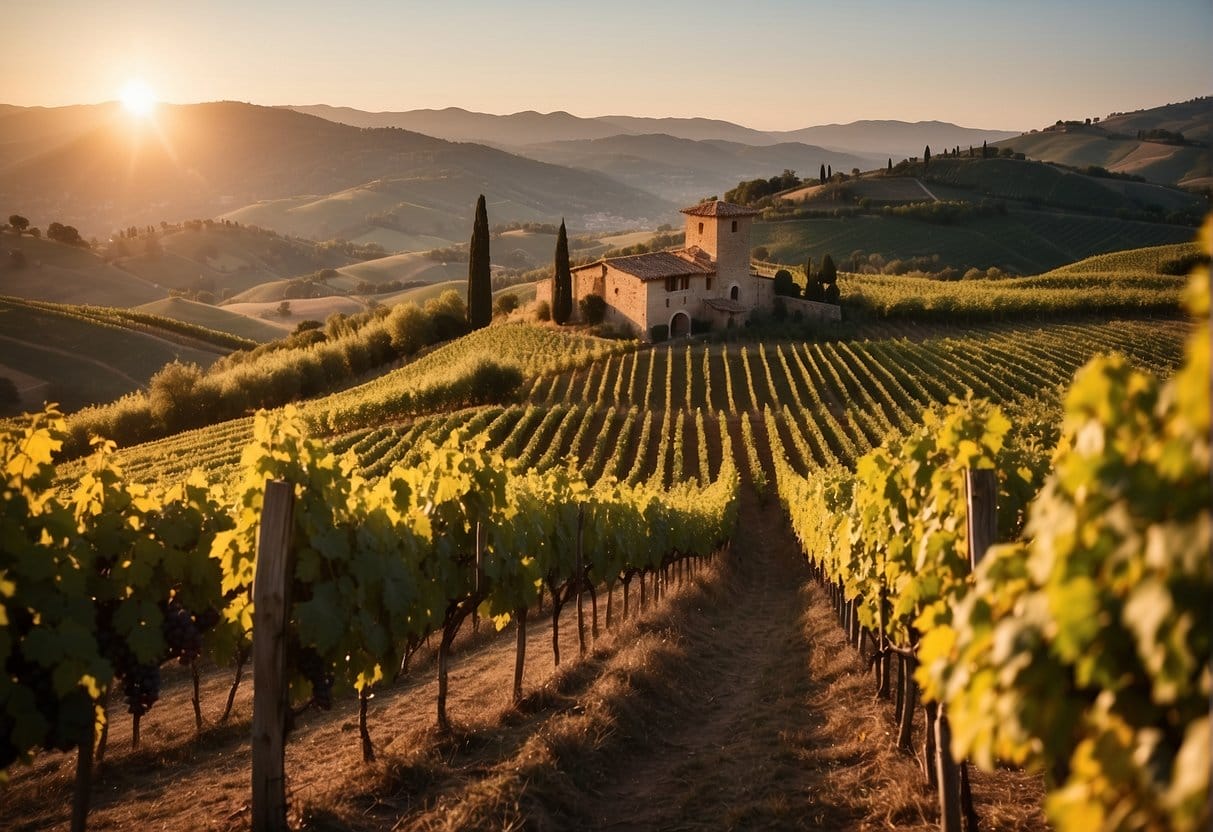
When you explore Central Italy, you plunge into a rich tapestry of wine regions known for their diverse and exceptional varietals. Let’s take a closer look at some of the hallmark areas and their cherished wines.
In Tuscany, you’ll find some of Italy’s most famous wines. It’s the home of Chianti, a red wine renowned globally for its ruby red color and savory flavor, primarily due to the Sangiovese grape. Not just any Chianti, Chianti Classico promises a higher quality, adhering to stricter standards. Tuscany is also where the prestigious Brunello di Montalcino and Vino Nobile di Montepulciano come to life, offering you a taste of aristocracy in a glass.
Move a little further and Montepulciano greets you with its namesake vino, known for its full-bodied character. Moreover, you might enjoy Vernaccia from San Gimignano, a crisp, dry white wine with a hint of minerality.
Venture into Umbria, and discover Sagrantino di Montefalco, a bold, tannic red, alongside the lighter, yet equally delightful Grechetto, a white grape often found in Orvieto blends.
Heading eastward to Marche, Verdicchio stands out as a star white that’s both zesty and refreshing. You’ll appreciate its versatility with food, or simply enjoyed by itself on a warm afternoon.
Don’t overlook Lazio, the region encompassing Rome, where Frascati wines offer pleasant, easy-drinking experiences, with volcanic nuances and fresh acidity.
Finally, when you arrive in Emilia-Romagna, get ready to toast with Lambrusco. This lightly sparkling red has an inviting fruitiness that can brighten any meal. Similarly, a glass of Sangiovese from this region reveals a more rounded and fruit-forward profile compared to its Tuscan cousin.
Tuscany Wine Region
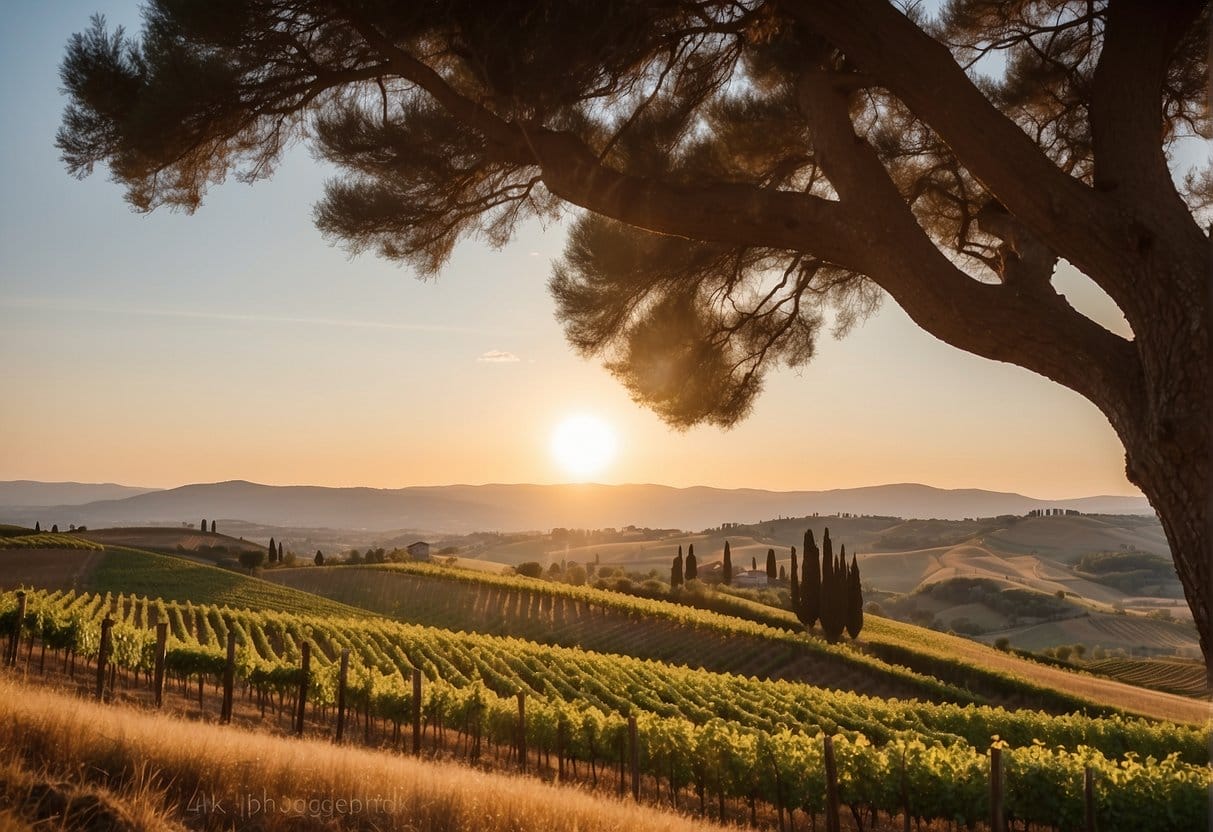
Tuscany is the heart of Italian wine culture, renowned for its rolling hills, endless vineyards, and the robust Sangiovese grape. It’s here that you’ll find the prestigious Chianti Classico area, a name synonymous with quality and tradition in Tuscan winemaking.
Chianti, notably set between the cities of Florence and Siena, offers a wide range of flavors, from fresh and fruity to rich and full-bodied. The Sangiovese grape dominates here, contributing to Chianti’s distinctive characteristics. To experience one of the best they have to offer, select a bottle labeled Chianti Classico, signifying higher quality and a link to the region’s most esteemed vineyards.
Venture further into Tuscany, and you’ll discover Montalcino, home to the esteemed Brunello di Montalcino. This powerful and age-worthy wine is created from a specific type of Sangiovese grape, known locally as Sangiovese Grosso. Brunello ages remarkably, with regulations requiring at least five years of aging before release.
Nearby lies Montepulciano, famous for its Vino Nobile di Montepulciano, a wine heralded for its elegance and aging potential. Not to be confused with the varietal Montepulciano used in the Abruzzo region, this wine is also predominantly made from Sangiovese.
For those seeking a break from tradition, Super Tuscans provide an innovative side to Tuscan wines. These typically use blends of non-traditional varieties such as Cabernet Sauvignon and Merlot, sometimes in combination with Sangiovese, pushing the boundaries of Tuscan wine styles.
Don’t overlook the white wines of Tuscany. The Vernaccia grape produces the esteemed Vernaccia di San Gimignano, recognized for its crispness and hints of mineral complexity – a fresh alternative to the region’s dominant reds.
| Key Wines | Notable Regions | Grape Varieties |
|---|---|---|
| Chianti Classico | Chianti | Sangiovese |
| Brunello di Montalcino | Montalcino | Sangiovese Grosso |
| Vino Nobile di Montepulciano | Montepulciano | Sangiovese |
| Super Tuscans | Tuscany-wide | Various, incl. International Varieties |
| Vernaccia di San Gimignano | San Gimignano | Vernaccia |
Embrace this exploration of Tuscany, and you’ll uncover a tapestry of tastes that continue to shape the world’s view of Italian excellence in wine.
Umbria Wine Region
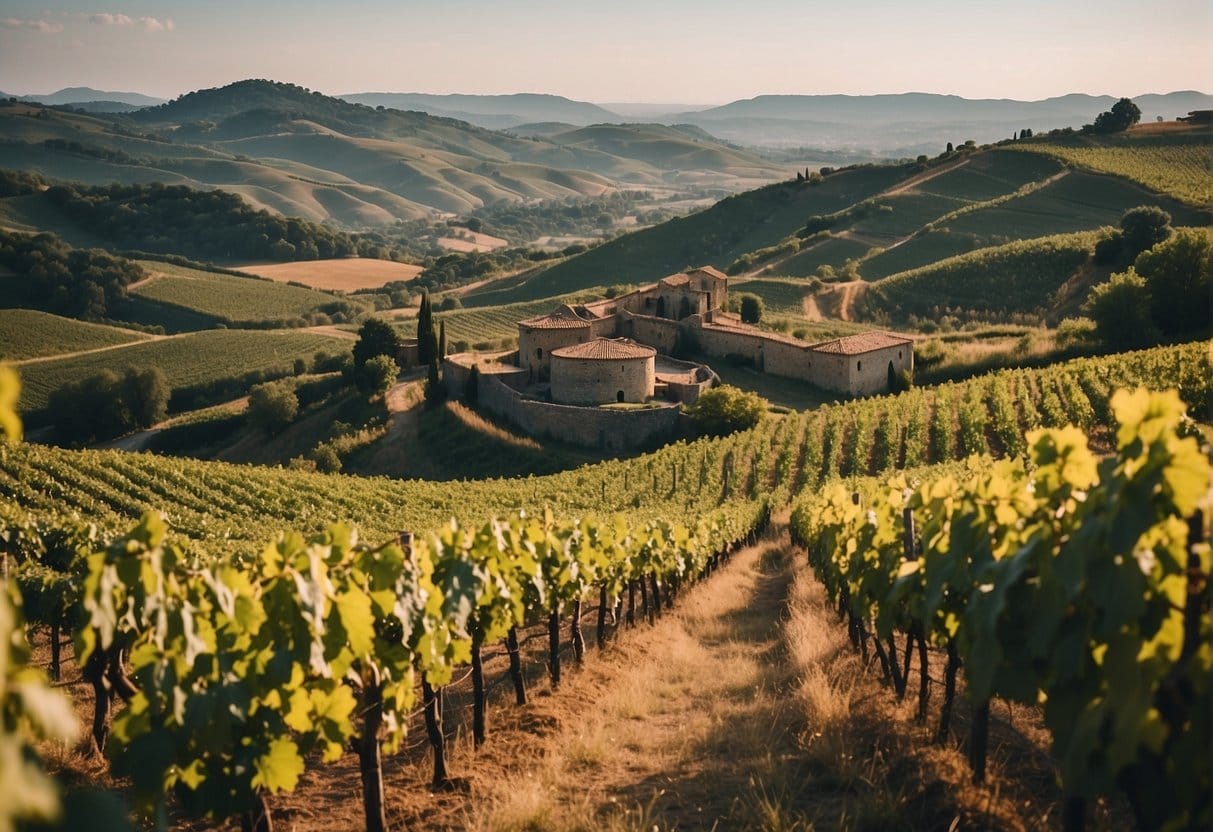
Located in the heart of Italy, Umbria is a region celebrated for its bucolic landscapes and rich vinicultural heritage. You’ll find yourself enchanted by the verdant rolling hills and the medieval towns that punctuate them, each with their own winemaking traditions.
Sagrantino, a grape variety indigenous to the region, is the jewel of Umbrian viticulture. Grown primarily around the village of Montefalco, these grapes produce robust red wines, known for their deep flavors and potential to age. If you have the chance to savor a glass of Montefalco Sagrantino, expect rich notes of dark fruits and earthy undertones.
In contrast to the bold Sagrantino, Umbria’s white wines offer graceful and aromatic profiles. Grechetto is a white grape that contributes greatly to these crisp wines, often bringing forth a delightful floral bouquet and a pleasant nutty finish.
Umbria is also home to the famous Orvieto, a historic city as well as the name given to both dry and sweet white wines produced in the area. The wines from Orvieto are primarily made from Trebbiano and Grechetto grapes, forming a harmonic blend that’s refreshing and light, with hints of green apple and white blossoms.
| Key Varieties | Description |
|---|---|
| Sagrantino | Full-bodied red with dark fruit flavors |
| Grechetto | White, nutty with floral notes |
| Orvieto | Light, mixed white, often with green apple notes |
While exploring this enchanting Italian wine region, you’ll discover that Umbrian wines offer a distinct taste of their native landscape, one that has been cultivated and cherished for centuries. Whether sipping a glass of Grechetto on a sunny terrace or enjoying a bold Sagrantino by the fireplace, the flavors of Umbria will transport you to a land of timeless charm and flavorsome wines.
Abruzzo Wine Region
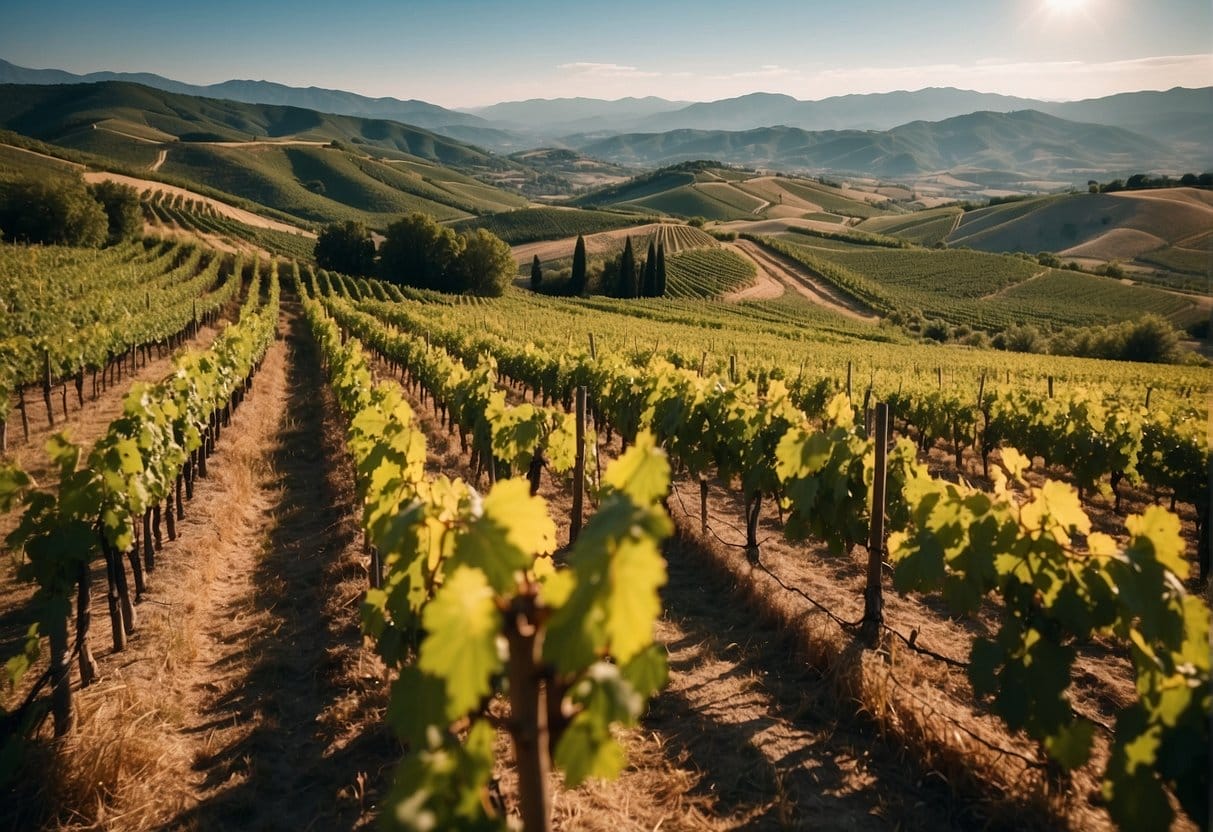
Abruzzo is known for its unique position along Italy’s east coast, combining mountainous terrain with a favorable coastal climate. Your exploration of Italian wines would be incomplete without sampling the vibrant offerings from this region.
In Abruzzo, Montepulciano stands out as the king of reds. Don’t confuse this grape with the Tuscan town of the same name. Montepulciano d’Abruzzo is a full-bodied red wine, boasting deep cherry notes and an earthy finish. For an in-depth look at Abruzzo’s wine scene, consider this guide to the Abruzzo wine region, which will introduce you to the complex aromas of these acclaimed wines.
As for whites, Trebbiano is the predominant variety. Trebbiano d’Abruzzo might be your perfect pick if you enjoy a refreshing, crisp wine with subtle fruit and floral nuances.
| Grapes in Abruzzo | Characteristics |
|---|---|
| Montepulciano | Full-bodied, cherry, earthy |
| Trebbiano | Crisp, floral, subtle fruit |
Your palate may also appreciate the region’s notable Rose wines, which are derived from the Montepulciano grape. These wines present a lighter, more approachable profile while maintaining the varietal’s characteristic flavors.
For a glimpse into the winemaking traditions and selections, Wine-Searcher’s editorial offers a comprehensive overview, including the region’s geographical neighbors and viticultural history.
When you indulge in Abruzzo’s wines, you’re experiencing a piece of Italian winemaking heritage that has been nurtured between the peaks of the Apennines and the breezes of the Adriatic Sea. Whether you’re new to Italian wines or an avid enthusiast, the wines of Abruzzo are sure to leave a memorable impression on your wine-tasting journey.
Marche Wine Region
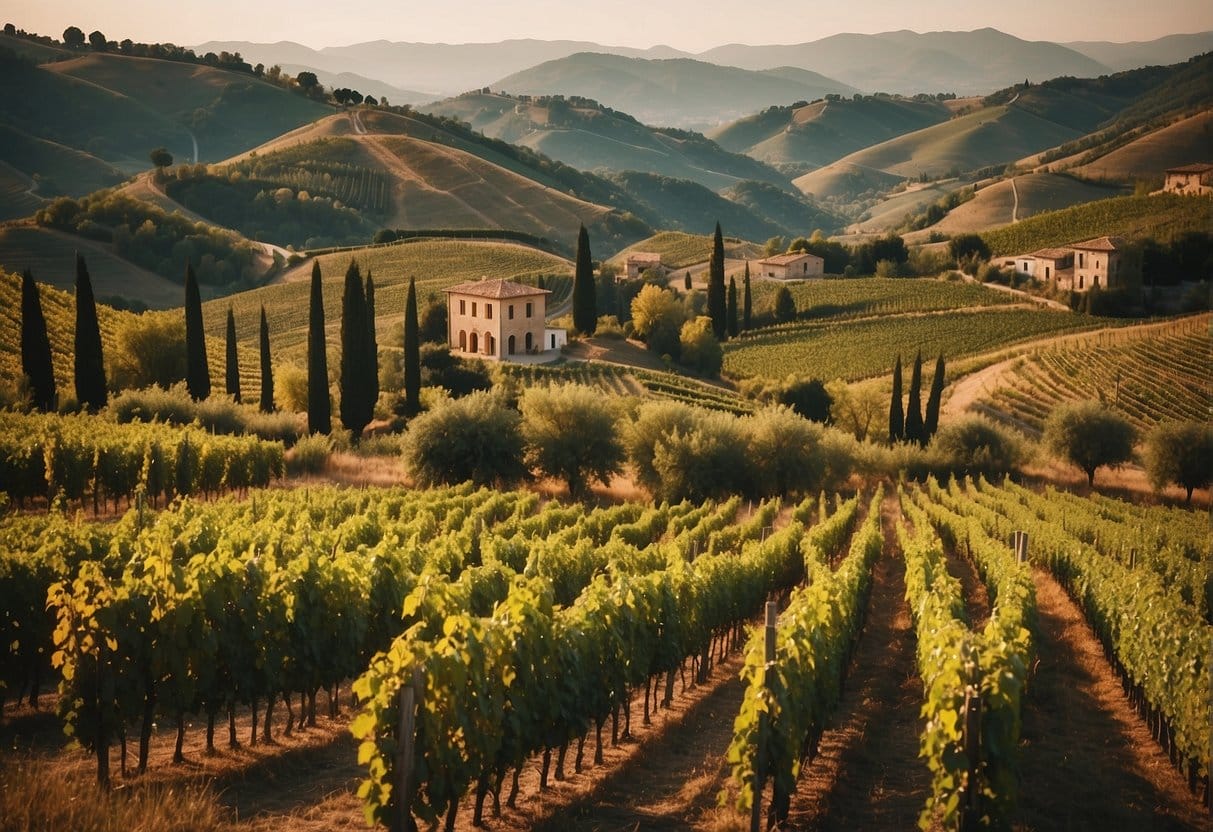
Located on the eastern side of central Italy, Marche is a wine region that offers a delightful exploration for your palate. Imagine yourself savoring the coastal breezes and the rich terroir that contribute to some of Italy’s most distinguished wines.
In Marche, you’re invited to discover the crisp and aromatic Verdicchio. This white grape variety flourishes here, offering you wines characterized by high acidity and a palate that often boasts of green apple and citrus notes.
As you indulge in Verdicchio, you may find that its versatility pairs beautifully with seafood, making it a staple for your alfresco dining experiences.
The region isn’t just about white wines though. Marche also nurtures red varieties, with Montepulciano being a notable mention. Wrap your senses around a glass of robust red, often revealing the earthy and dark fruit qualities ideal for pairing with the region’s hearty cuisine.
Marche’s Wine Highlights:
- White Wines:
- Verdicchio: Known for its high acidity and a distinct almond note on the finish.
- Red Wines:
- Predominantly made from Montepulciano and Sangiovese grapes.
To enrich your knowledge, drink in the history and present craft by visiting local wineries. Revel in tastings that offer both organically farmed wines and those that have won awards for their excellence.
Remember, Marche extends beyond just grapevines; it encompasses a tasting journey that embraces Italian wine culture in every sip. Whether it’s a light and zesty Verdicchio or a deep and earthy red that you crave, let your taste voyage begin in the heart of Italy’s Marche region.
Lazio Wine Region
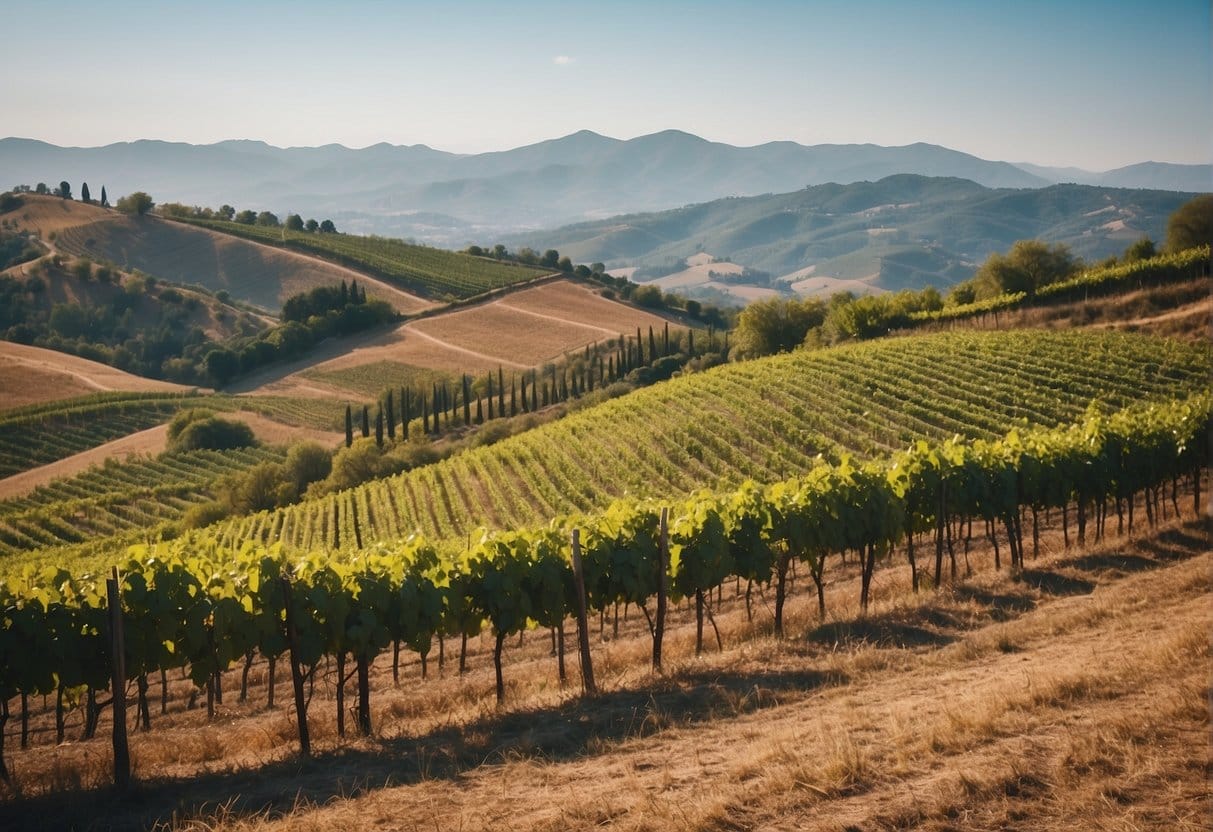
Nestled in central Italy, Lazio is a lush wine region that cradles the historical city of Rome. You’ll find that this region’s winemaking heritage is steeped in history, with vineyards dotting the picturesque landscapes around the bustling capital.
Lazio is particularly renowned for its white wines, which prominently feature grapes like Trebbiano and various styles of Malvasia. Among these, Malvasia di Candia and Malvasia Puntinata are notable for their aromatic characteristics.
Here’s a snapshot of what you might encounter when exploring the Lazio wine region:
- Main White Grapes: Trebbiano, Malvasia di Candia, Malvasia Puntinata
- Notable Wine Styles:
- Frascati: Often described as fresh and lively, this wine is a must-try from the hills southeast of Rome.
The Lazio region, while ancient in tradition, has adapted to modern tastes. It has upheld its reputation throughout the centuries, especially around the areas like Frascati, where the wines range from bone-dry to delicately sweet. When you visit, you’ll experience a harmonious blend of cultural depth and oenological prowess, right in the heart of Italy.
As Rome serves as the vibrant hub for the region, you’ll find your wine-tasting journey intertwined with a wealth of history and majestic ruins. Whether you’re exploring wine estates or enjoying a glass of crisp white in a local enoteca, Lazio offers a warm welcome with flavors that have been cherished since antiquity.
Emilia-Romagna Wine Region
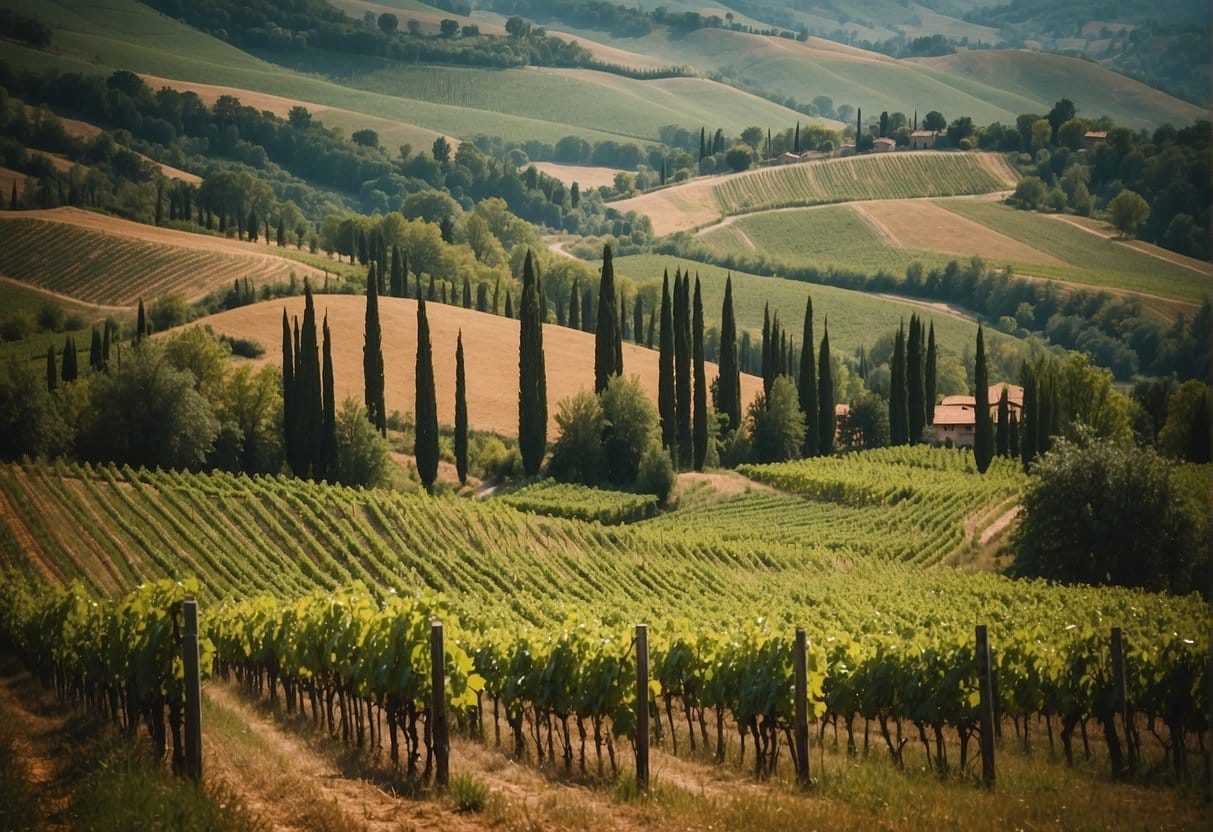
Emilia-Romagna, situated in the northern part of Italy, is a treasure trove for wine enthusiasts like yourself. This region boasts a rich winemaking tradition, with the Lambrusco varieties gaining international recognition for their delightful effervescence and fruit-forward flavors. Here, you’ll find a range of Lambrusco wines, from dry to sweet, that cater to every palate.
Key Varietals
- Lambrusco: Celebrated for its sparkling reds.
- Sangiovese: Known for its full-bodied and robust reds.
In Emilia-Romagna, wine production is deeply rooted in local culture. You will notice the wines reflect their terroir, showcasing unique characteristics influenced by the region’s climate and soil. If you’re keen on exploring the Lambrusco DOCs, you’ll encounter options like Salamino di Santa Croce and Grasparossa di Castelvetro, each with its distinctive profile, which you can learn more about on Wine-Searcher.
Alongside Lambrusco, you shouldn’t overlook the notable Sangiovese of Emilia-Romagna. These wines are praised for their harmonious blend of acidity and tannins, often offering a pleasant cherry note and an earthy touch.
When you plan your wine tour to this region, be prepared for more than just wine. Emilia-Romagna is also the birthplace of culinary staples like Parmigiano Reggiano cheese and Parma Ham, which pair beautifully with your wine selections. To aid in planning your visit, check out resources like Winetourism.com that offer comprehensive guides to the wine region.
Remember, a journey through Emilia-Romagna’s vineyards offers a blend of traditional viticulture and indulgent gastronomy, set against the backdrop of Italy’s enchanting scenery.
Southern Italian and Island Wine Regions
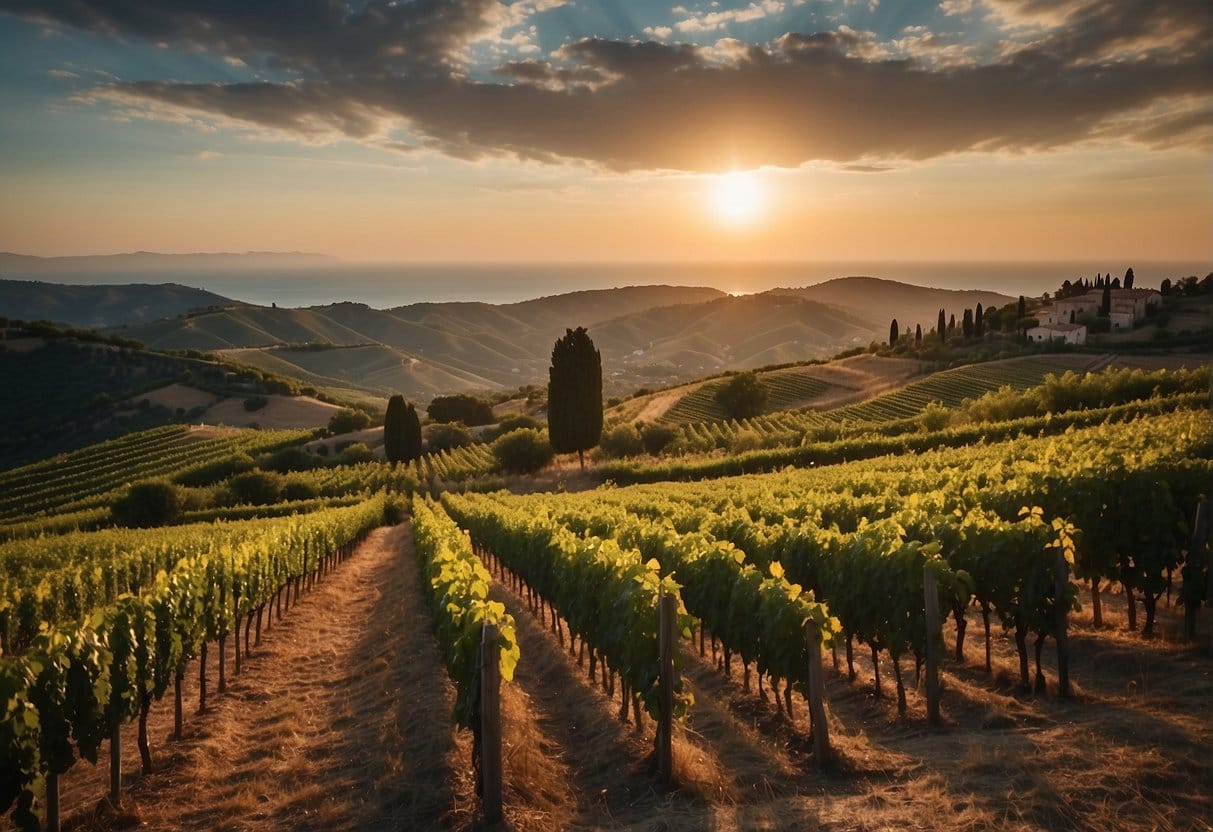
Southern Italy and its islands boast a diverse array of wine regions that are as rich in flavor as they are in culture. As you explore these regions, you’ll find that each has something distinct to offer.
In Sicily, the warmth of the Mediterranean sun ripens grapes to perfection, giving life to robust reds such as Nero d’Avola and Nerello Mascalese. These wines are known for their bold flavors and pair wonderfully with the hearty local cuisine. Sicily is also home to Marsala, a fortified wine often used in cooking, and white varietals like Grillo, which offer a crisp freshness perfect for a balmy evening.
Sardinia introduces you to Cannonau—a red wine rich with antioxidants—and the aromatic white Vermentino. As you sip on these, you’ll catch notes of the island’s unique terroir, imbued with mountain herbs and coastal breezes.
Heading over to the boot of Italy, Puglia is a treasure trove for wine lovers. Here, the robust red Primitivo makes its stand, bold and inviting, alongside Negroamaro, which is both earthy and savory. These wines are ideal companions to the region’s rich, tomato-based dishes.
Campania, with its volcanic soils, gives rise to the powerful red Aglianico and the delicate white Fiano, wines that encapsulate the essence of the local landscape.
Moving inland, you’ll uncover Basilicata’s take on Aglianico, known as Aglianico del Vulture, which is grown on ancient volcanic grounds. This results in a complex and intriguing wine that leaves a lasting impression.
Lastly, Calabria offers the Greco grape, producing wines that are as lively and spirited as the region itself.
Embrace these regions with an open heart, and you’ll find your wine collection growing not just in size, but in stories and memories.
| Region | Notable Grapes |
|---|---|
| Sicily | Nero d’Avola, Marsala, Grillo |
| Sardinia | Cannonau, Vermentino |
| Puglia | Primitivo, Negroamaro |
| Campania | Aglianico, Fiano |
| Basilicata | Aglianico |
| Calabria | Greco |
Remember, as you embark on your wine journey through these enchanting regions, each glass echoes the history and character of its birthplace.
Sicily Wine Region
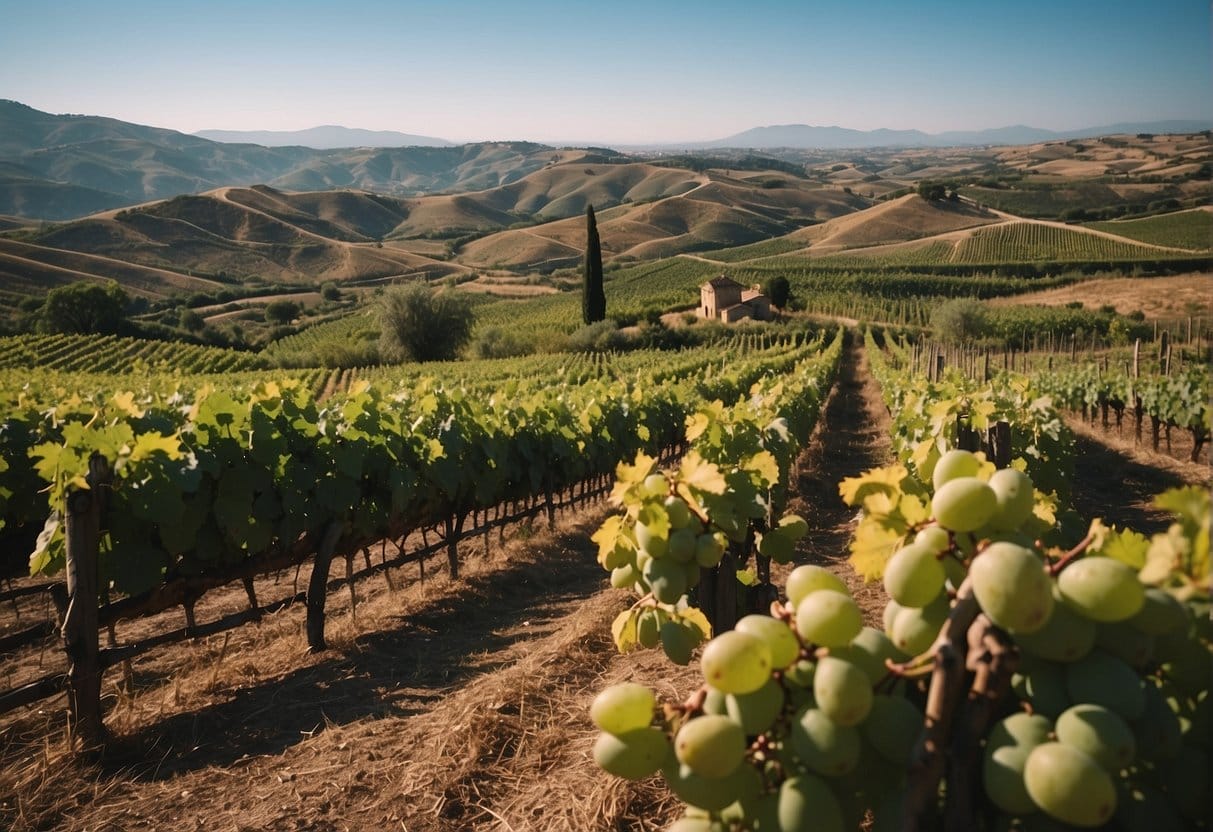
Sicily, an island with a heritage deep-rooted in winemaking, offers rich and robust wines such as the Nero d’Avola, a flagship grape variety. You’ll find that this grape creates wines that are full-bodied and offer a pleasant bouquet of ripe fruits and sweet spices.
Marsala, Sicily’s iconic fortified wine, originated from the region sharing its name. It has a complex flavor profile, ranging from sweet to dry, and is often used in cooking due to its unique taste.
Below are the key grape varieties native to Sicily:
- Nero d’Avola: Often used in blends to add depth and cherry aromas
- Nerello Mascalese: Typically grown on the slopes of Mount Etna, producing elegant and aromatic wines
- Grillo: Provides a refreshing and light-bodied option, with hints of lemon and herbs
Sicily’s wine scene is notable for its commitment to organic practices. A substantial 34% of the vineyards in Sicily adopt organic farming, paving the way for sustainable viticulture.
With over 65 native varieties and vineyards reaching elevations as high as 3,900 ft, your palate is in for a treat. The diversity of the wines reflects the region’s varied terroirs, each contributing unique notes and characteristics.
Sardinia Wine Region
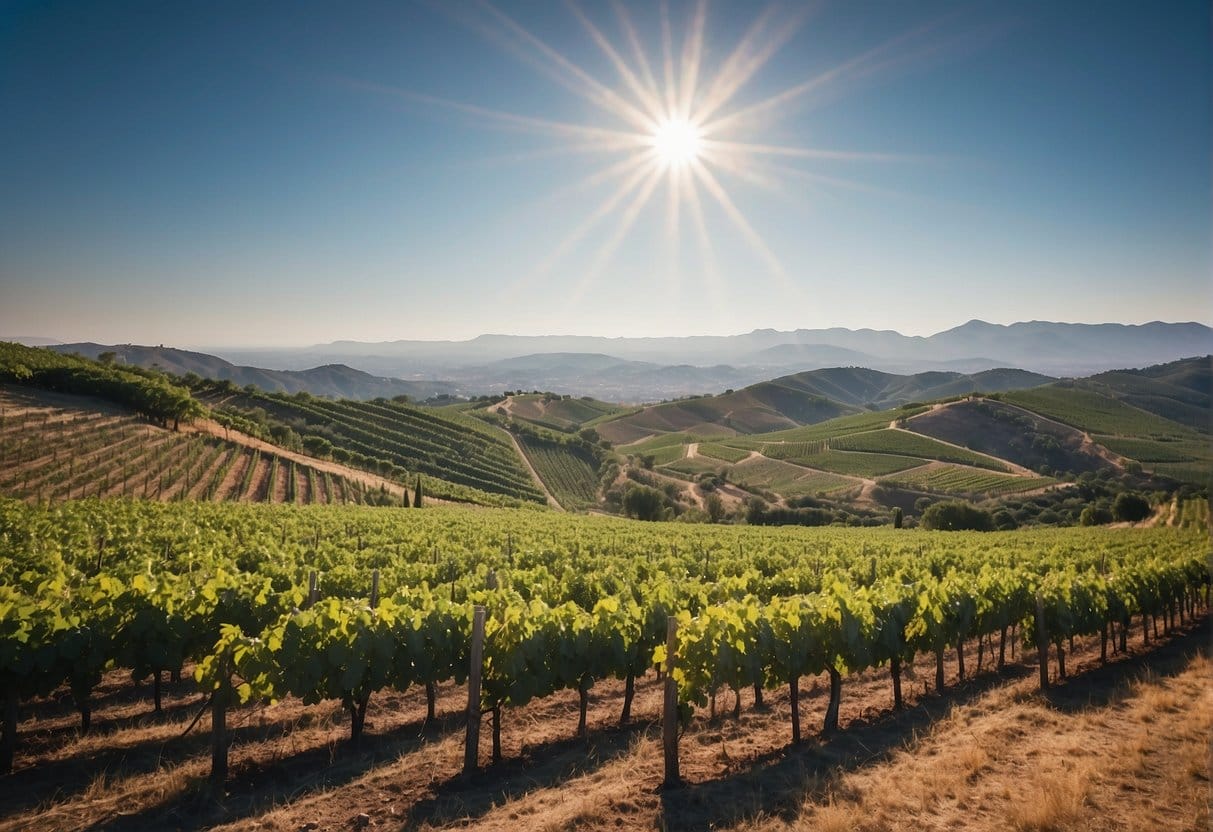
Sardinia, your sunny Mediterranean escape, is not just known for its crystal-clear waters but also as a distinguished wine region of Italy. Home to an array of unique varietals, the island offers you a taste of its rich winemaking traditions.
One of the stars of Sardinia is Cannonau, a bold red wine that matches the intensity of the local culture. This grape variety is noted for its high antioxidant content, and when you sip on a glass of Cannonau, you’re enjoying a wine that embodies the island’s winemaking spirit.
Vermentino is another gem you’ll find in Sardinia. This fragrant white wine is perfect for a sunny day, with its notes of citrus and green apple, and it pairs wonderfully with the island’s seafood offerings. It’s the ideal companion to elevate your coastal dining experience.
Sardinia’s wine prowess isn’t limited to these two varieties. You’ll discover other indigenous grapes that contribute to the island’s wine mosaic:
- Carignano
- Monica
- Nuragus
When exploring Sardinian wines, take note of these key regions:
- Vermentino di Gallura DOCG
- Cannonau di Sardegna DOC
- Carignano del Sulcis DOC
Each of these areas offers you wines that are as diverse and inviting as the island’s terrain. Experience the tradition of Sardinian winemaking here, and let the flavors transport you to the heart of the Mediterranean.
Puglia Wine Region
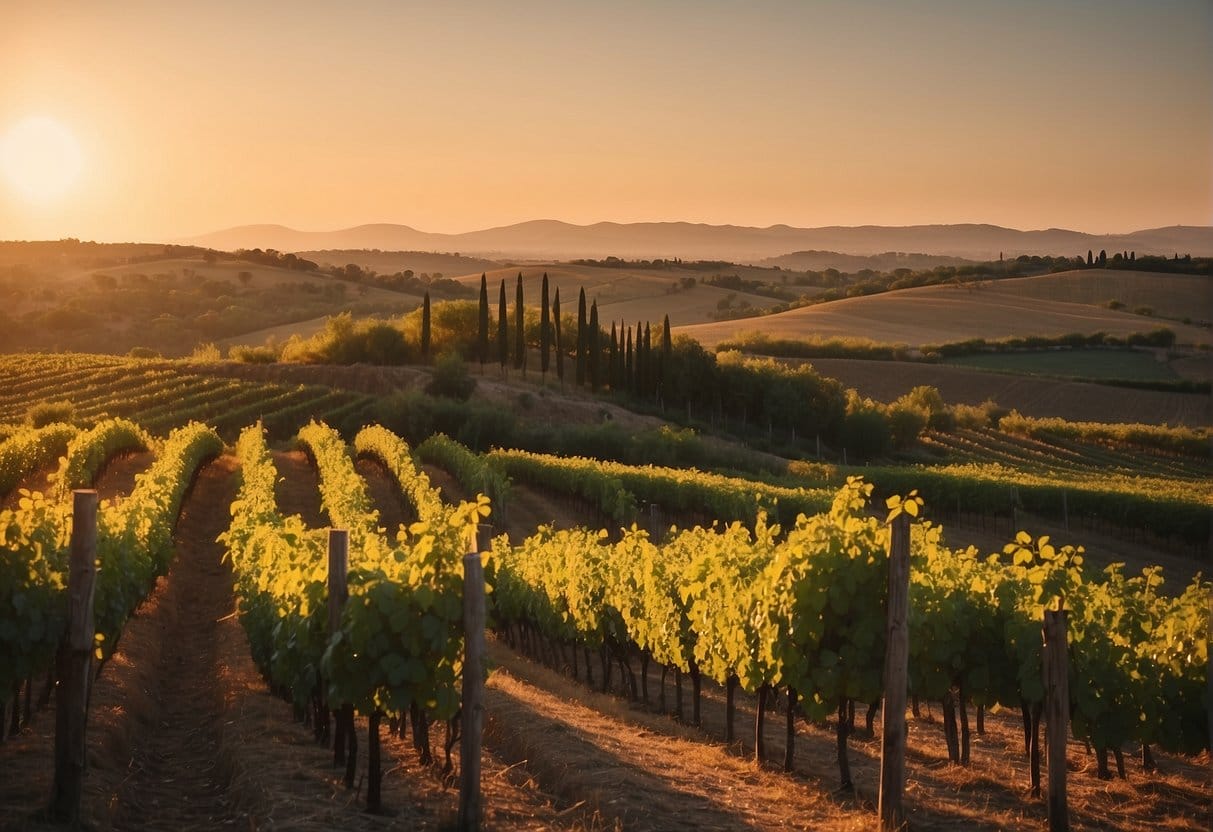
Your journey through the wine regions of Italy isn’t complete until you’ve explored Puglia. Nestled in the southeastern corner of Italy’s famous “boot,” this long, beautiful region, also known to English speakers as Apulia, offers an abundance of vineyards under its warm Mediterranean sun.
Primitivo and Negroamaro are the stars here, with Primitivo leading the charge as Puglia’s most recognized grape variety. You might find its full-bodied and robust nature reminiscent of its genetic twin, Zinfandel. This grape thrives in the region’s rich red soils, basking in the generous sunshine to produce wines with ripe fruit flavors and a hint of spice.
Here’s a quick snapshot of Puglia’s wine essentials:
- Primary Grapes: Primitivo, Negroamaro, Sangiovese, Trebbiano
- Climate: Mediterranean with hot and dry summers
- Notable Wines: Salice Salentino, made predominantly from Negroamaro grapes, and often noted for its pleasantly bitter finish.
When you explore Puglia’s wines, you’re not just tasting the local bounty—you’re immersing yourself in a deep history that dates back to the 8th century BC with the arrival of the Greeks. Today, while sipping on a glass of ruby red, you’re part of a story that continues to unfold with every harvest.
Remember, whether you’re looking to visit Puglia for its attractions or simply wish to explore its wines from home, you’ll discover a region with a wine style that matches its warm and inviting atmosphere. Enjoy the relaxed lifestyle through every bottle from this quintessentially Italian terrain.
Campania Wine Region
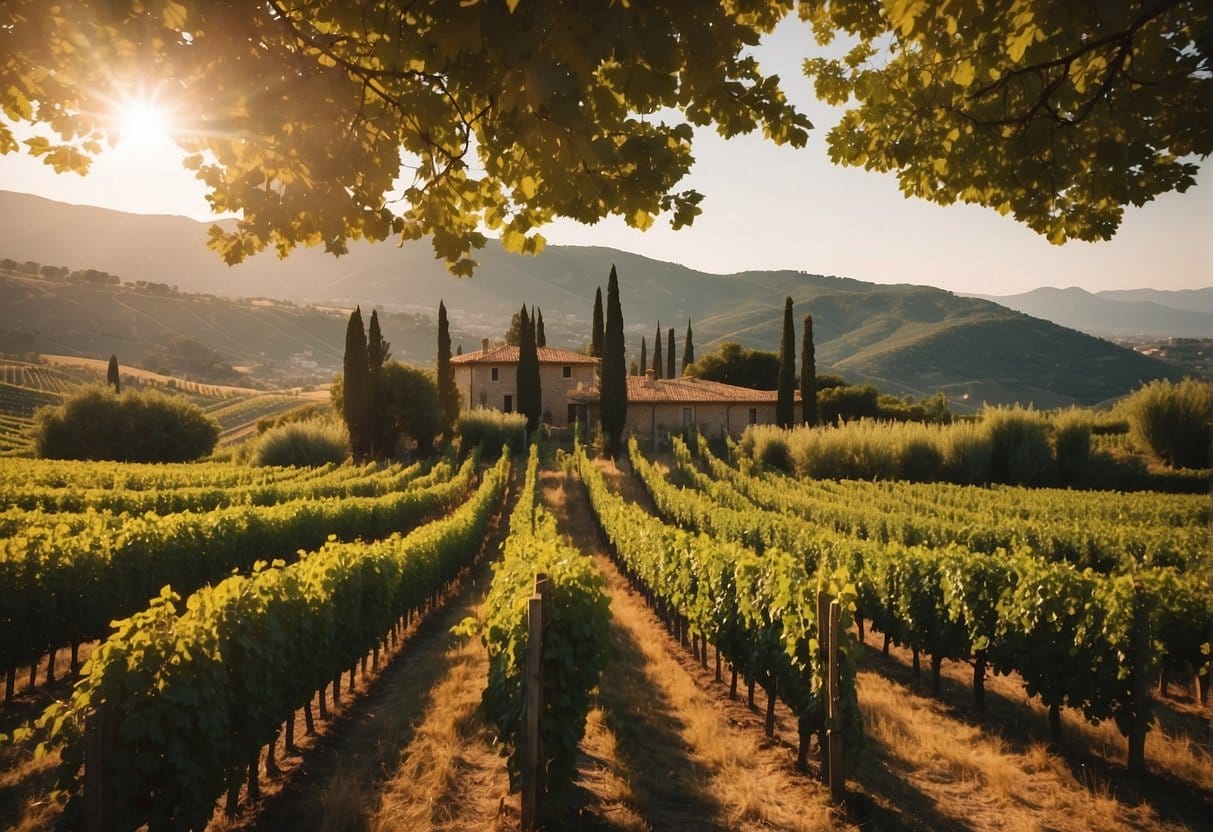
Situated in southern Italy, Campania is a region steeped in viticultural history. With Naples as its bustling capital, this area offers you an array of delicious wines, distinguished by unique flavors due to its volcanic soils. Here is what you should know about Campania’s wine production:
Grapes Varieties
- Aglianico: This is the star red grape of the region, used to produce the robust Taurasi, often referred to as the “Barolo of the South” for its depth and aging potential.
- Fiano: On the white side, Fiano leads, creating wines that are aromatic and age-worthy, often with a pleasant hint of honey.
Notable Wines
- Taurasi: Made from Aglianico, this red wine is known for its rich flavor and excellent aging capability.
- Fiano di Avellino: A white wine with enticing aromas and a potential for aging, crafted from Fiano grapes.
Wine Characteristics
- Reds are typically full-bodied, with a firm tannic structure and a bouquet of dark fruits and spices.
- Whites tend to be medium-bodied, showcasing floral and fruit notes, with a refreshing acidity.
As you explore Campanian wines, you’ll notice the presence of mineral undertones in many bottles, a signature of the region’s volcanic terroir. This unique feature adds complexity and a sense of place to every sip you take. Whether you choose the bold Aglianico or the fragrant Fiano, expect to find a wine that is authentically Campanian – vibrant, expressive, and captivating.
For more detailed insights on the varieties and wine-making traditions of the area, you can delve into comprehensive guides like the one from Wine-Searcher.
Basilicata Wine Region
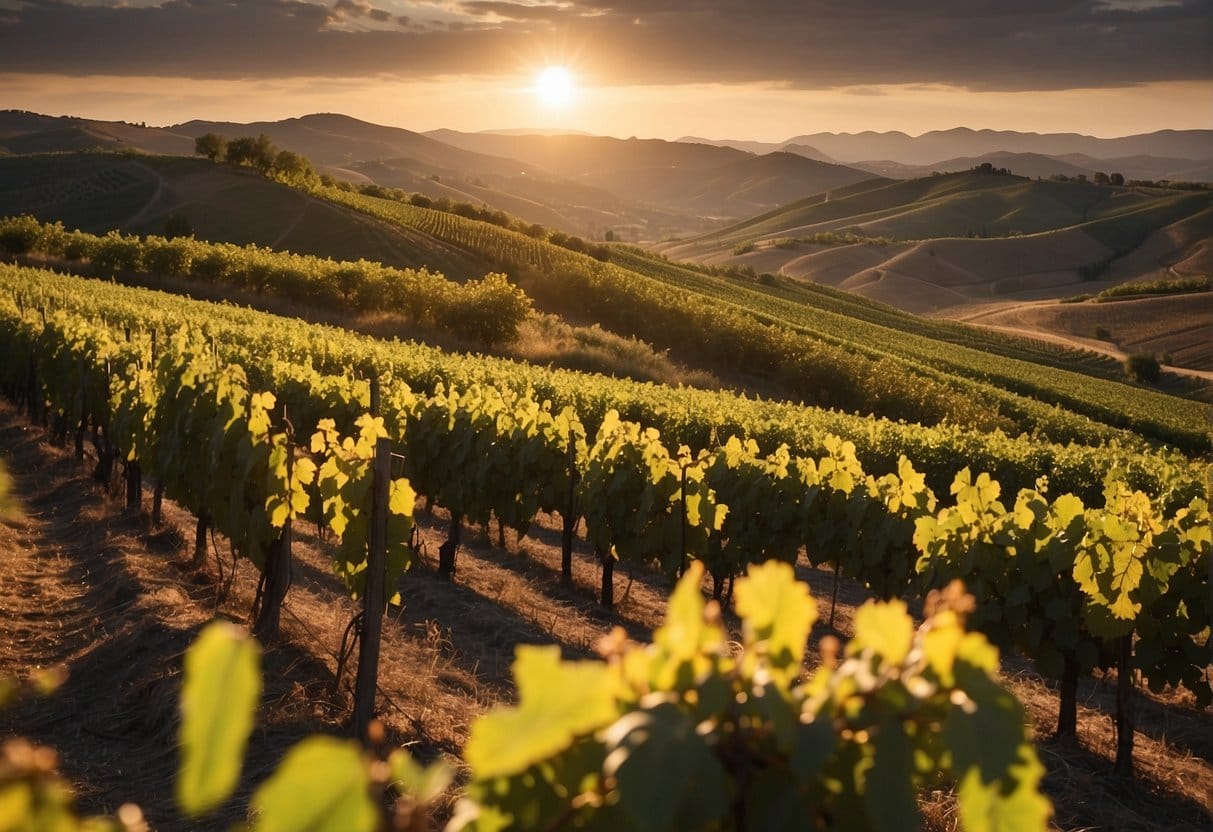
Nested in the southern part of Italy, Basilicata is a hidden gem amongst Italian wine regions. You’ll find it tucked between Calabria and Apulia, a land rich with ancient winemaking traditions.
The region’s volcanic soil and unique microclimates contribute to the distinct characteristics of Basilicata wines. The star of the show is undoubtedly the Aglianico grape, known for its ability to produce robust and full-bodied red wines. The most renowned Aglianico-based wine you’ll encounter is Aglianico del Vulture, which leverages the mineral-rich soils surrounding the extinct Mount Vulture volcano for an exquisite complexity.
| Grape Varieties | Notable Wine |
|---|---|
| Aglianico | Aglianico del Vulture |
Your wine exploration in Basilicata will reveal a landscape of vineyards that are small in size but majestic in quality. Due to its more obscure location, compared to other Italian regions, Basilicata offers you a chance to dive into an intimate winemaking experience steeped in tradition.
If you’re planning a visit or simply curious about the wines you can discover, the region’s offerings range from fine, age-worthy red wines to more accessible varieties that still reflect the region’s volcanic legacy.
While Basilicata may not occupy the top spot on Italy’s winemaking stage, its wines, particularly from the Aglianico grape, stand as a testament to the region’s potential and the growing interest amongst connoisseurs and casual drinkers alike.
Calabria Wine Region
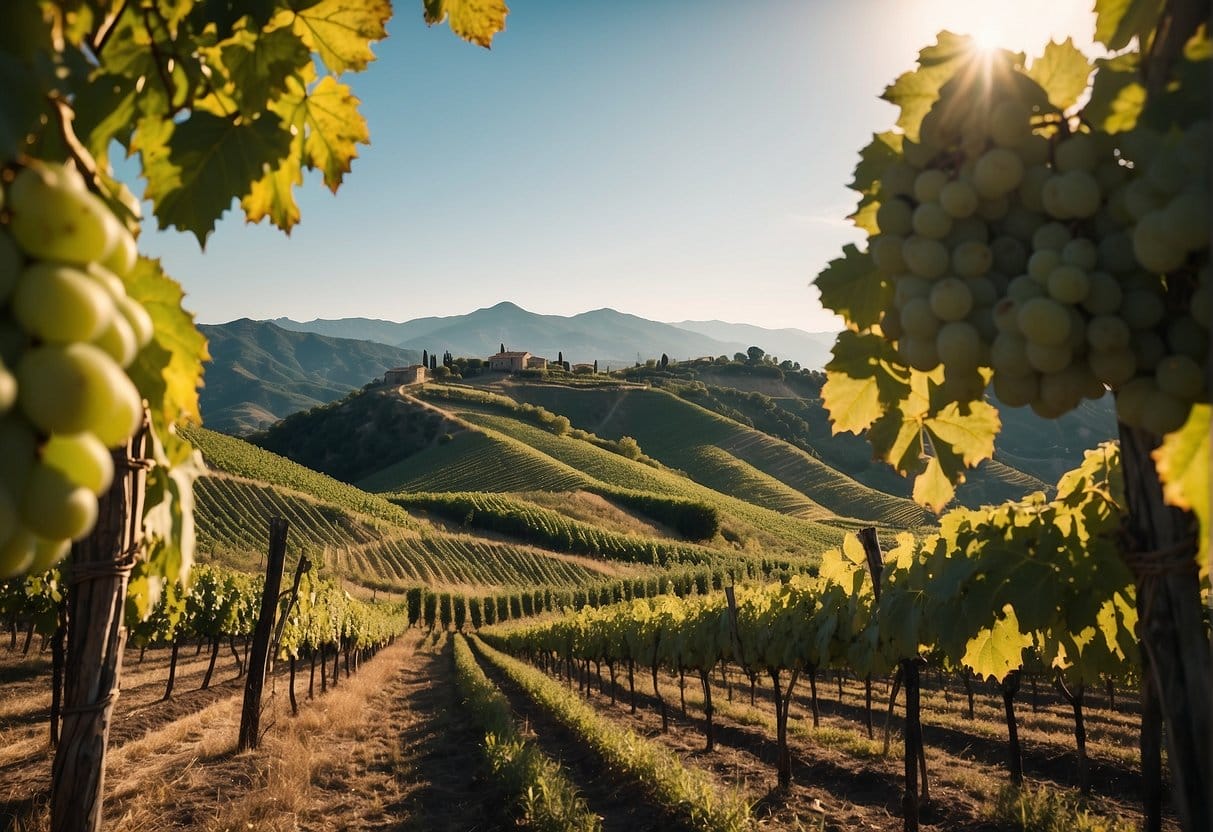
In the Calabria wine region, you’ll encounter the rustic charm of southern Italy. Imagine the diverse landscape as you sip on unique varietals from this province: sun-kissed shores and rugged mountain terrains provide an ideal backdrop for vineyards.
Key Varietals
- Gaglioppo: A cornerstone red grape producing robust wines.
- Greco: Used for both white wines and blends, giving you a taste of Calabria’s diverse winemaking.
Wine Production
- Red Wine: Calabria is prominent for its red wines, with over 90% attributed to red wine production.
- DOC Designation: A select portion of wine qualifies as Denominazione di origine controllata (DOC), ensuring quality and regional authenticity.
Wineries and Experiences
Have a memorable wine tasting experience at local estates. You can book a visit to places that offer not just wine but also olive oil and an authentic Italian agritourismo experience.
Location and Climate
- Surrounded by water, with the Ionian Sea to the east and Tyrrhenian Sea to the west, grape growing in Calabria benefits from the Mediterranean climate.
- Proximity to the Strait of Messina invites gentle sea breezes that moderate the vineyards’ climate.
Getting Started
Whether you are just beginning your wine journey or reigniting an old passion, exploring Calabrian wines offers a unique path. Enjoy the heart of Italian winemaking by exploring its poorest recognized yet historically rich wine territory. Your palate will thank you for trying the wines from this sun-drenched toe of Italy‘s boot.
Understanding Italian Wine Labels
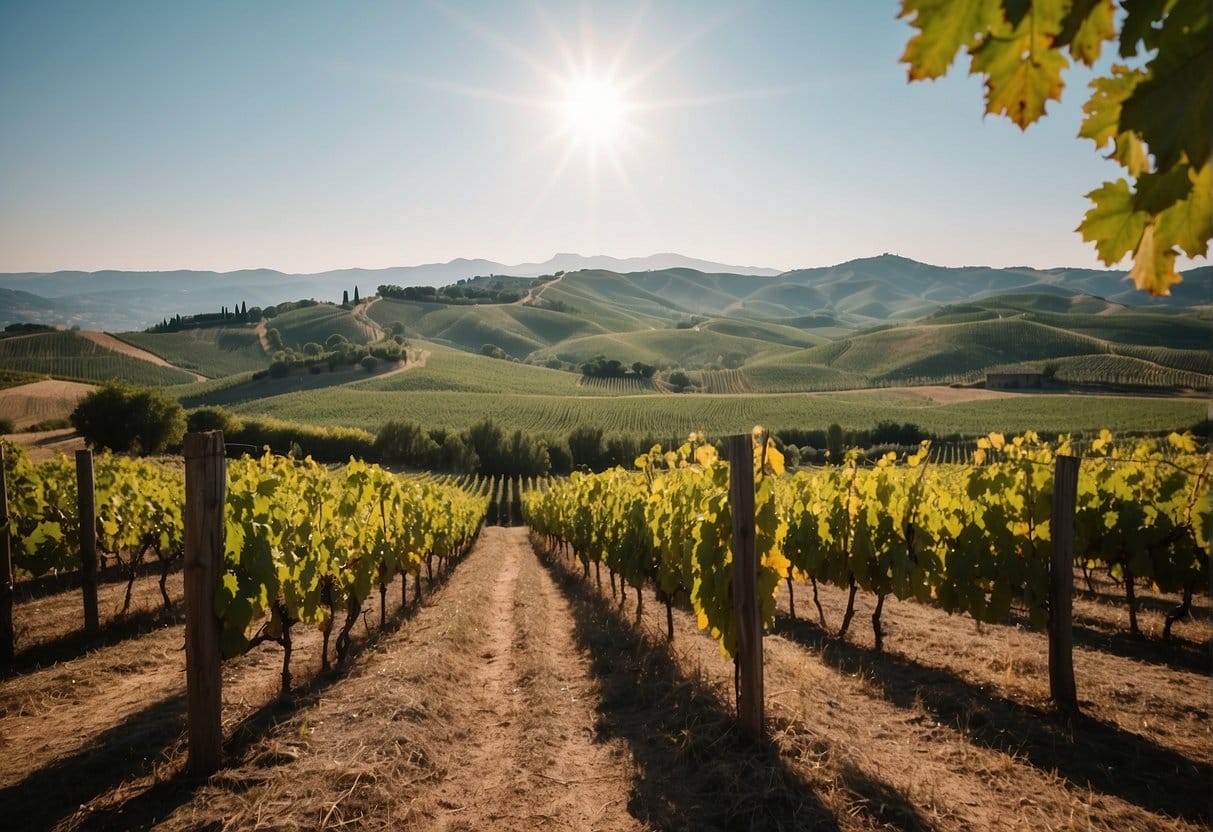
Exploring Italian wine labels is like going on a treasure hunt where every term and symbol reveals secrets about the wine’s origin, quality, and character. Let’s decode the puzzle together and discover what your bottle has to tell you.
Deciphering Label Terminology
Italian wine labels are filled with terms that indicate the style, quality, and origin of the vino. “Classico” refers to a wine produced in the original heartland of the region, often with a storied history of wine production. For instance, Chianti Classico denotes a higher-quality zone within the larger Chianti area. Understanding these terms helps you identify the provenance and heritage of your chosen bottle.
Regional Quality Indicators and Classifications
Italy’s wine classification system is vital to understanding the quality and authenticity of wine. DOCG (Denominazione di Origine Controllata e Garantita) marks the highest quality, with Brunello di Montalcino and Amarone della Valpolicella as illustrious examples.
DOC (Denominazione di Origine Controllata) indicates a level just below, with an array of widely respected wines like Vino Nobile di Montepulciano. The IGT (Indicazione Geografica Tipica) classification means the wine has certain regional characteristics without the strict guidelines of DOC/DOCG. Recognizing these indicators empowers you to make informed choices about the wine’s quality.
| Classification | Meaning |
|---|---|
| DOCG | Top tier, strict rules, guaranteed quality |
| DOC | High quality, specific regions, controlled production |
| IGT | Regional character, more flexible in terms of production |
Vintages and Producer Information
The vintage year stamped on your bottle signifies when the grapes were harvested, which can tip you off about the climate conditions and therefore, the potential taste profile of the wine. For example, a warm growing season might produce grapes with more sugar, leading to a fuller-bodied wine.
Also, the producer’s name is a hallmark of quality, as certain wineries have built reputations for excellence through generations of dedicated wine production. Paying attention to these details can give you clues about the wine’s character before you even take the first sip.
Pairing Food with Italian Wines
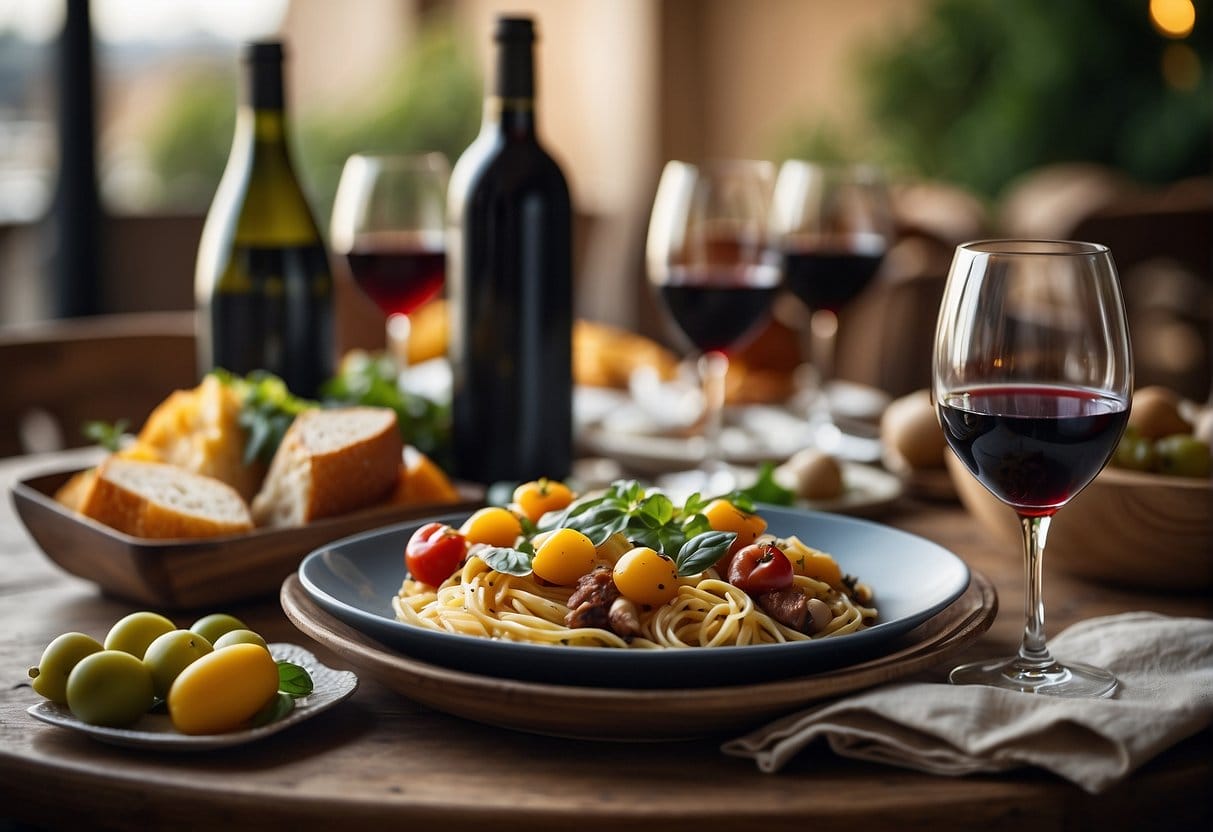
Discovering the perfect wine to complement a meal enhances your dining experience, especially when it comes to the rich variety offered by Italian wines. Each wine is a reflection of the region it originates from, crafted to pair beautifully with local cuisine.
Traditional Pairings by Region
In Tuscany, the robust flavors of Chianti wines are a classic match for the region’s hearty pastas and game meats. Moving to Piedmont, the bold Barolo—often called the king of wines—exquisitely pairs with truffle dishes and rich stews. Over to Sicily, where the intense aromas of an Amarone elegantly complement the area’s savory meat dishes.
White Wines and Seafood
With Italy’s extensive coastline, seafood is a staple and pairs wonderfully with white wines. A crisp Pinot Grigio from the northern regions is a delightful accompaniment to light fish plates. Further south, a glass of Vermentino brings out the flavors in a sumptuous seafood pasta. The central Italian Verdicchio grape produces wines that enhance the delicate taste of shellfish.
Italian Red Wines and Heartier Dishes
Your robust meals deserve a wine that stands up to the challenge. Indulge in a plate of osso buco with the tannic structure of a Chianti supporting every bite. For your winter roasts, find comfort in the rich layers of a Barolo or Amarone.
Sparkling Wines for Celebrations
Celebrations call for bubbles! Prosecco, from the Veneto region, is a go-to for its fruity notes and approachable price point. For more prestigious occasions, the elegance of Franciacorta with its complex and creamy texture pairs perfectly with appetizers and can even carry through an entire meal.
Visiting Italian Wine Regions
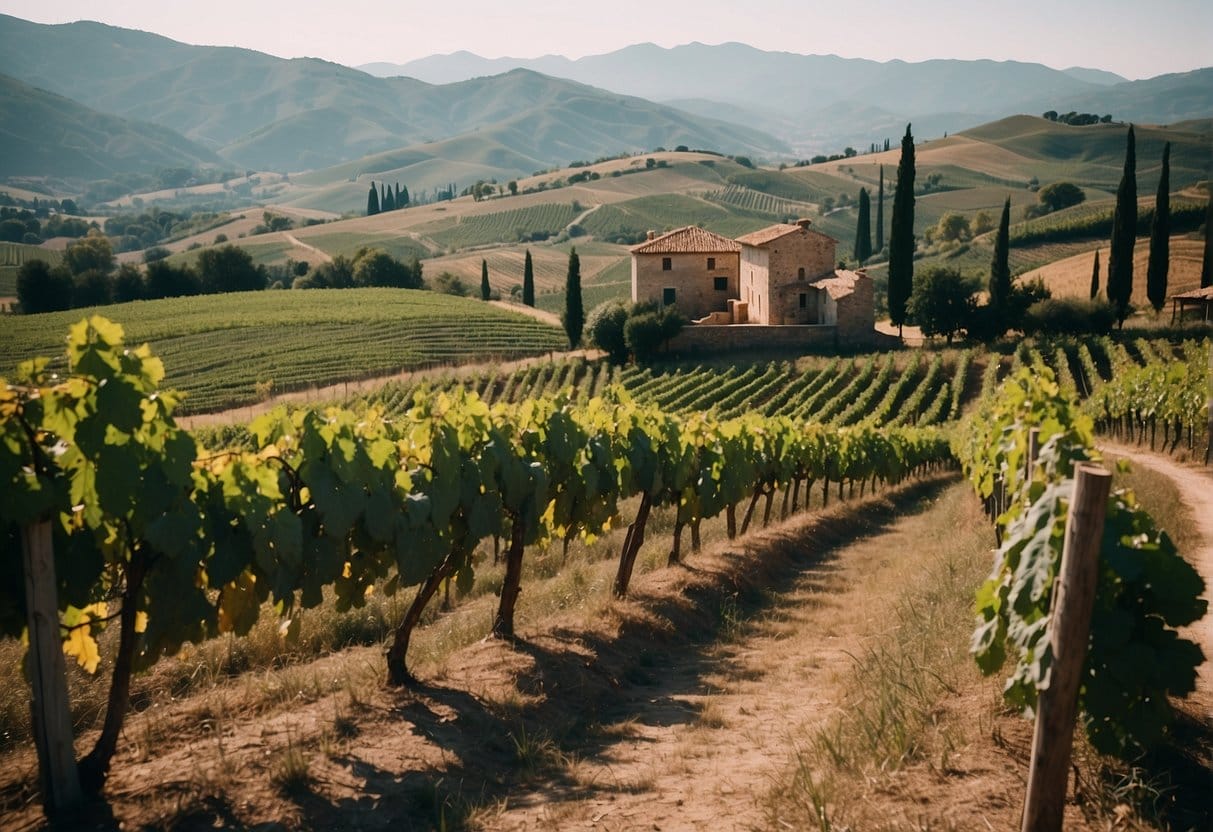
Italy offers an array of unforgettable wine-tasting experiences, featuring world-renowned varieties and picturesque vineyards. As you explore, you will find each region offering a unique glimpse into the country’s viticultural diversity.
Popular Tours and Tasting Experiences
Engage in guided tours through Tuscany, where the Chianti Classico zone stands out as a highlight. Your journey might start with a sensory experience of sipping rich, red wines while learning about the distinct characteristics that define local vintages. You can participate in sessions that teach the art of Italian wine pairing, enhancing your culinary adventure.
Exploring Vineyards and Winery Estates
As you roam through the Italian wine regions, expect to be greeted by sprawling vineyards set against the backdrop of Italy’s lush landscapes. Venture to winery estates, where you can witness first-hand the meticulous process of winemaking, from grape-picking to bottling. Don’t miss the opportunity to meet knowledgeable vintners who share insights into age-old traditions.
Guide to Planning a Wine Region Itinerary
Planning your wine region itinerary requires careful consideration of the places you’re most eager to explore. Use a map to navigate through Italy’s wine regions, marking out spots like Piedmont’s truffle-rich territories or Sicily’s sun-kissed estates. Schedule your visits during harvest time for an immersive experience, or opt for the quieter off-season to enjoy personal encounters with winemakers.
Conservation and Sustainability in Italian Winemaking
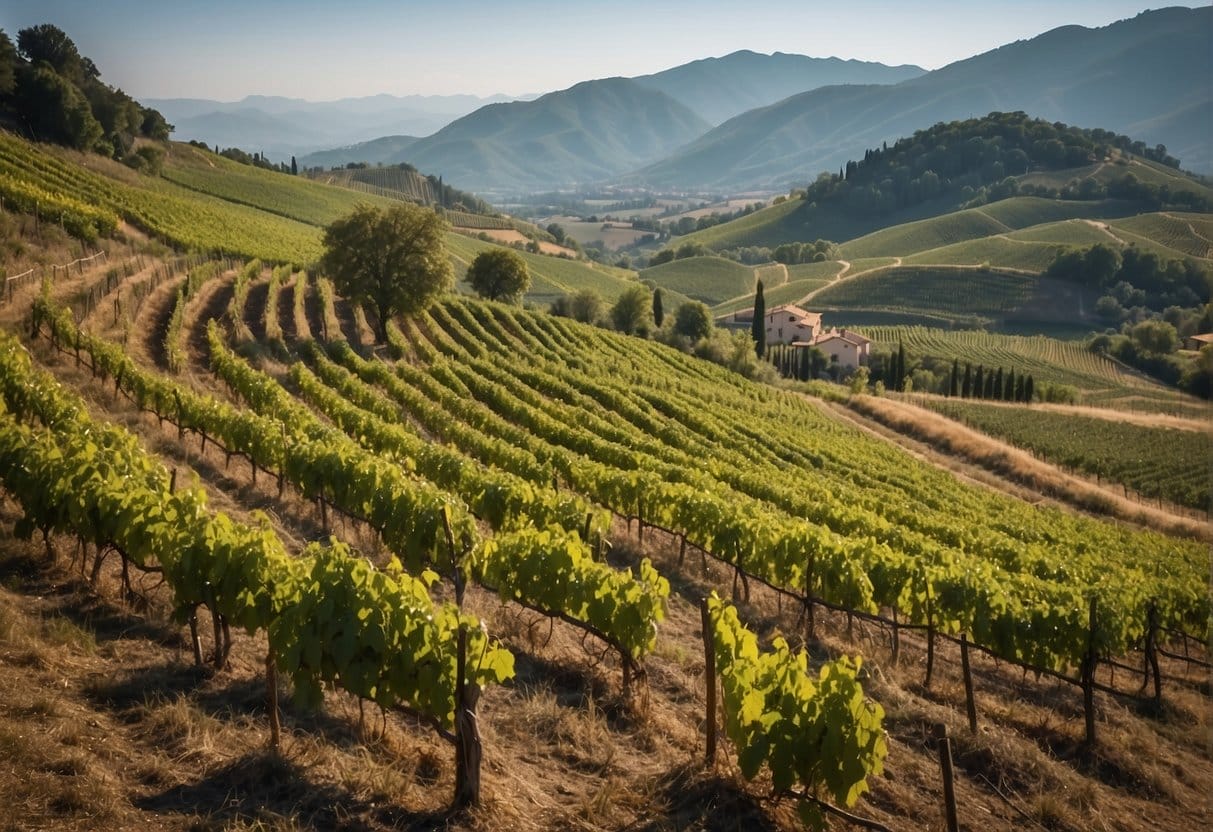
You’ll discover that Italy’s commitment to conservation and sustainability is strongly reflected in its winemaking processes. From embracing organic farming methods to adopting cutting-edge techniques, the Italian wine industry is at the forefront of environmentally conscious viticulture.
Organic and Biodynamic Practices
Italy is renowned for its organic and biodynamic winemaking methods. By prioritizing the health of the soil and the ecosystem, vineyards across the nation from Tuscany to Sicily are producing wines that not only tell the story of their terroir but also support the wellbeing of the planet. Biodynamic agriculture takes this a step further, treating the vineyard as a self-sustaining organism and using preparations based on local herbs and minerals to enhance biodiversity.
Innovations in Sustainable Viticulture
Innovation drives sustainability in Italian wine production. Dynamic initiatives include reducing water usage, employing renewable energy sources, and embracing technology to monitor vineyard conditions. These efforts minimize the industry’s carbon footprint and pave the way for a future where winemaking and environmental stewardship go hand in hand.
Protecting Native Grape Varieties
Italy takes pride in its heritage, consistently working to protect and promote its native grape varieties. Rare grape varieties are not just a treasure trove of biodiversity; they also signify the essence of Italian wine identity. By nurturing these vines, winemakers ensure that the rich tapestry of Italy’s wine heritage continues to flourish for generations to come.
Frequently Asked Questions
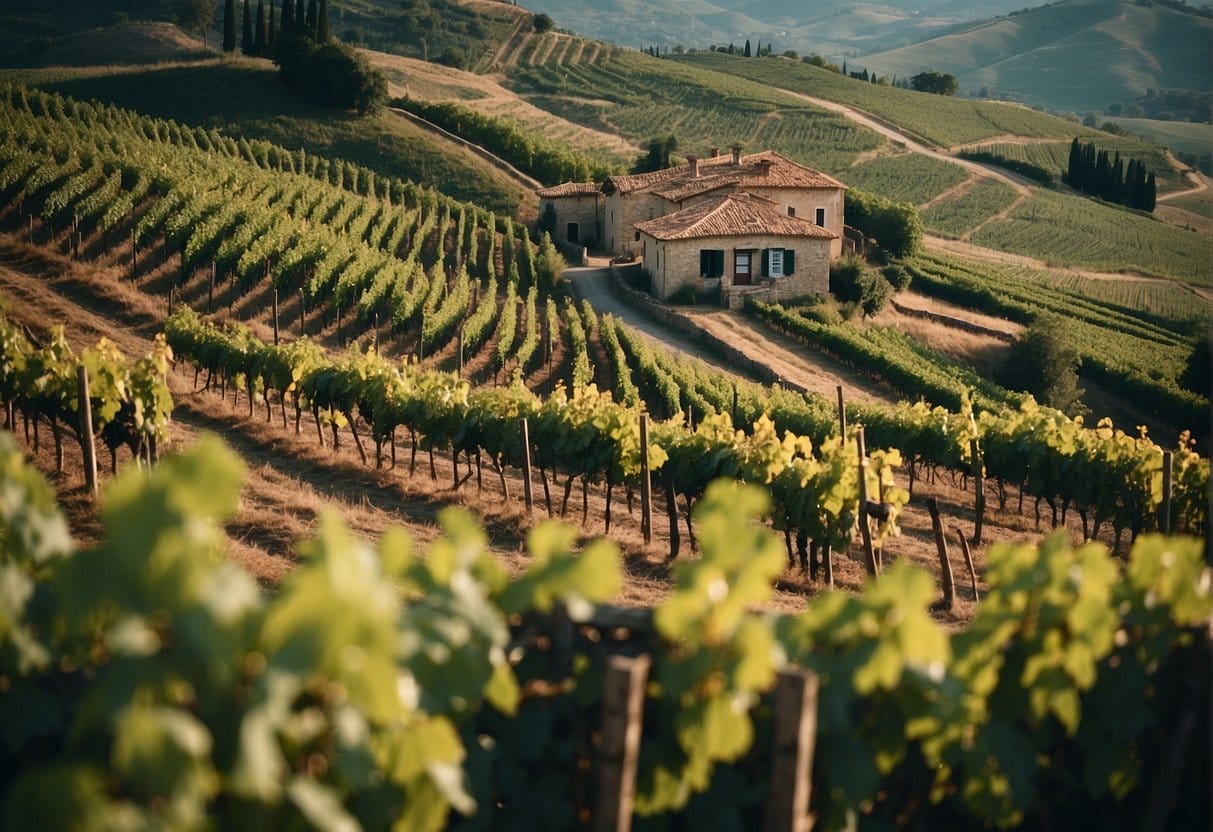
In this section, you’ll find answers to common questions about Italy’s renowned wine regions. Gain insights into the characteristics of Piedmont, the white wines across Italy, the uniqueness of Veneto, and much more.
What are the key characteristics that define Piedmont as a wine region?
Piedmont stands out for its esteemed Barolo and Barbaresco wines, often referred to as the “King and Queen” of Italian wines. They are known for their richness, complexity, and aging potential, mainly attributed to the Nebbiolo grape, which thrives in the region’s cool climate and foggy conditions. Further info on Piedmont’s wine characteristics can be found here.
Can you provide a guide to the different white wines produced in Italy?
Italy offers a diverse array of white wines, from the crisp, minerally Verdicchio and Trebbiano to the aromatic whites of Gewürztraminer and Moscato. Each wine reflects the climate and terroir of its region, offering a range from light and zesty to rich and full-bodied. Discover more about Italy’s white wines here.
What makes Veneto stand out among other Italian wine-producing areas?
Veneto is renowned for its production of Prosecco, a beloved sparkling wine, and the rich, velvety Amarone della Valpolicella. This region’s winemaking prowess is attributed to its diverse climates, enabling a variety of wine styles including lighter whites and robust reds. Explore more about Veneto’s wine offerings here.
Could you list the Italian regions recognized for their exceptional wine production?
Italy is home to several regions celebrated for their exceptional wines, including Tuscany, known for Chianti and Brunello di Montalcino; Piedmont, with its Barolo and Barbaresco; Veneto, famous for Prosecco and Amarone; and Sicily and Sardinia with their rich heritage and indigenous grape varieties. A comprehensive list of these regions is available here.
How can one explore the diversity of wines across Italy’s various districts?
To explore Italy’s wine diversity, consider visiting local vineyards and tasting rooms where you can sample an array of wines. Participating in wine tours provides insights into the wine-making process and the unique aspects of each district’s viniculture. For ideas on regions to visit, check this guide.
Which area in Italy is considered the premiere destination for wine enthusiasts?
While several regions offer unforgettable experiences, Tuscany is often considered the premier destination for wine lovers. Its iconic rolling hills, historical estates, and the renowned Sangiovese grape all contribute to Tuscany’s reputation. Be sure to explore regions like Chianti Classico and Montalcino to immerse yourself in the heart of Italian winemaking. Get more information on visiting Tuscany here.
